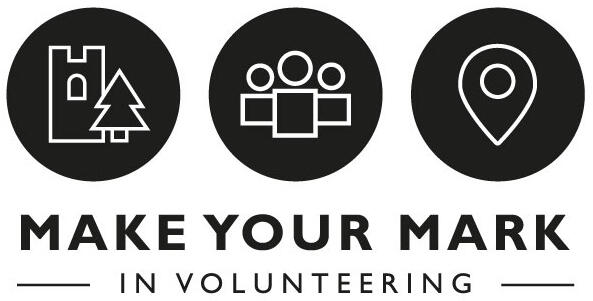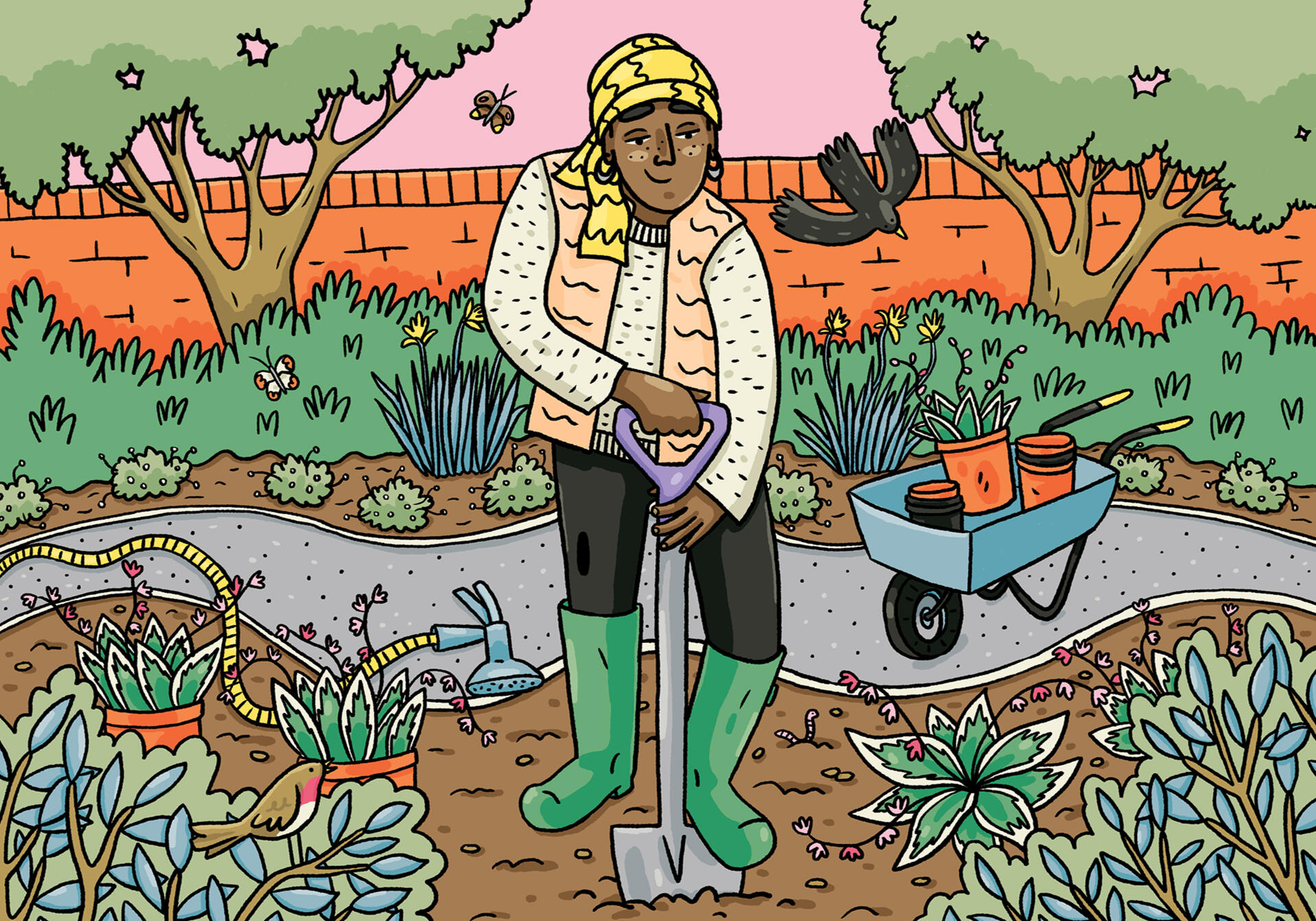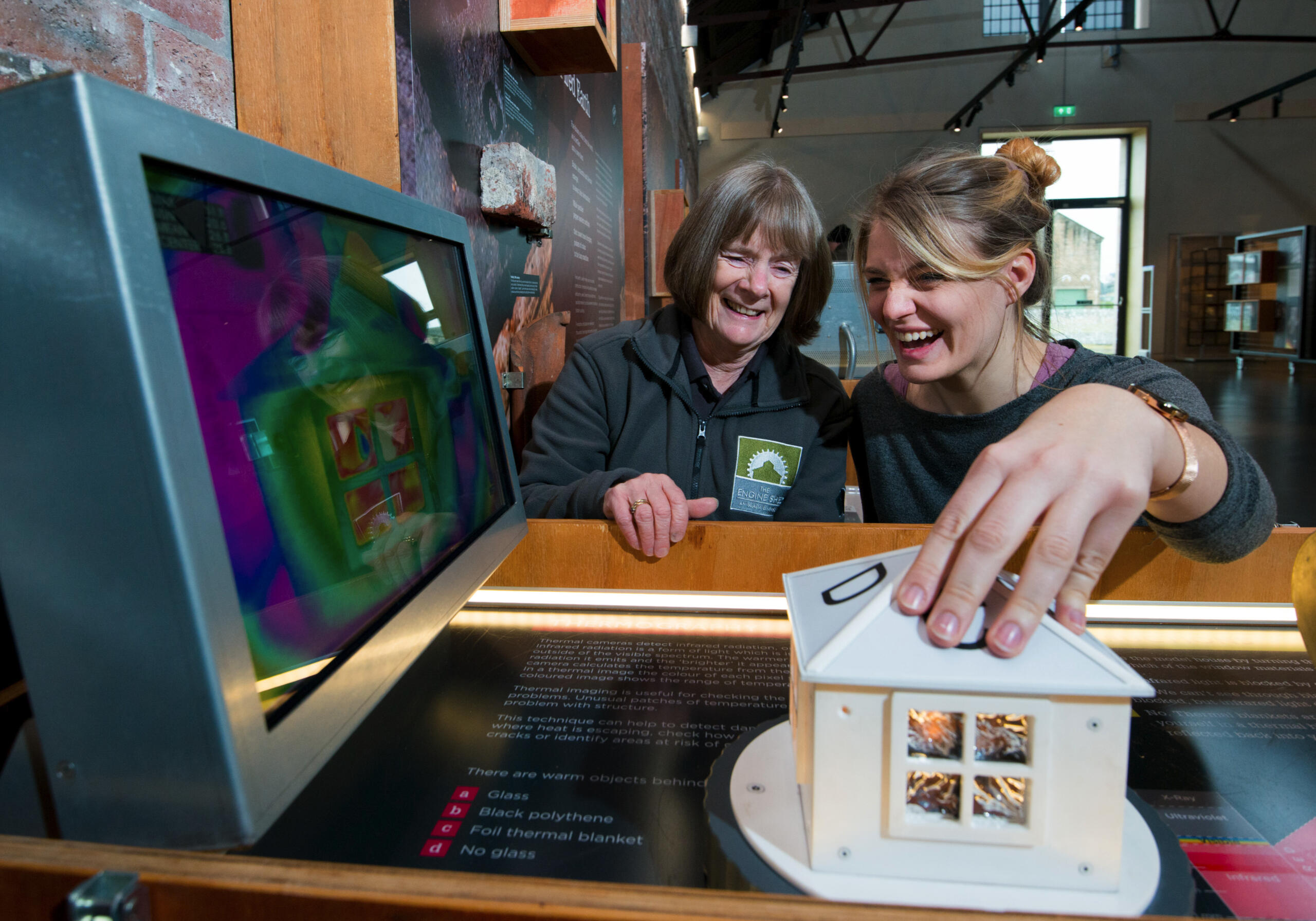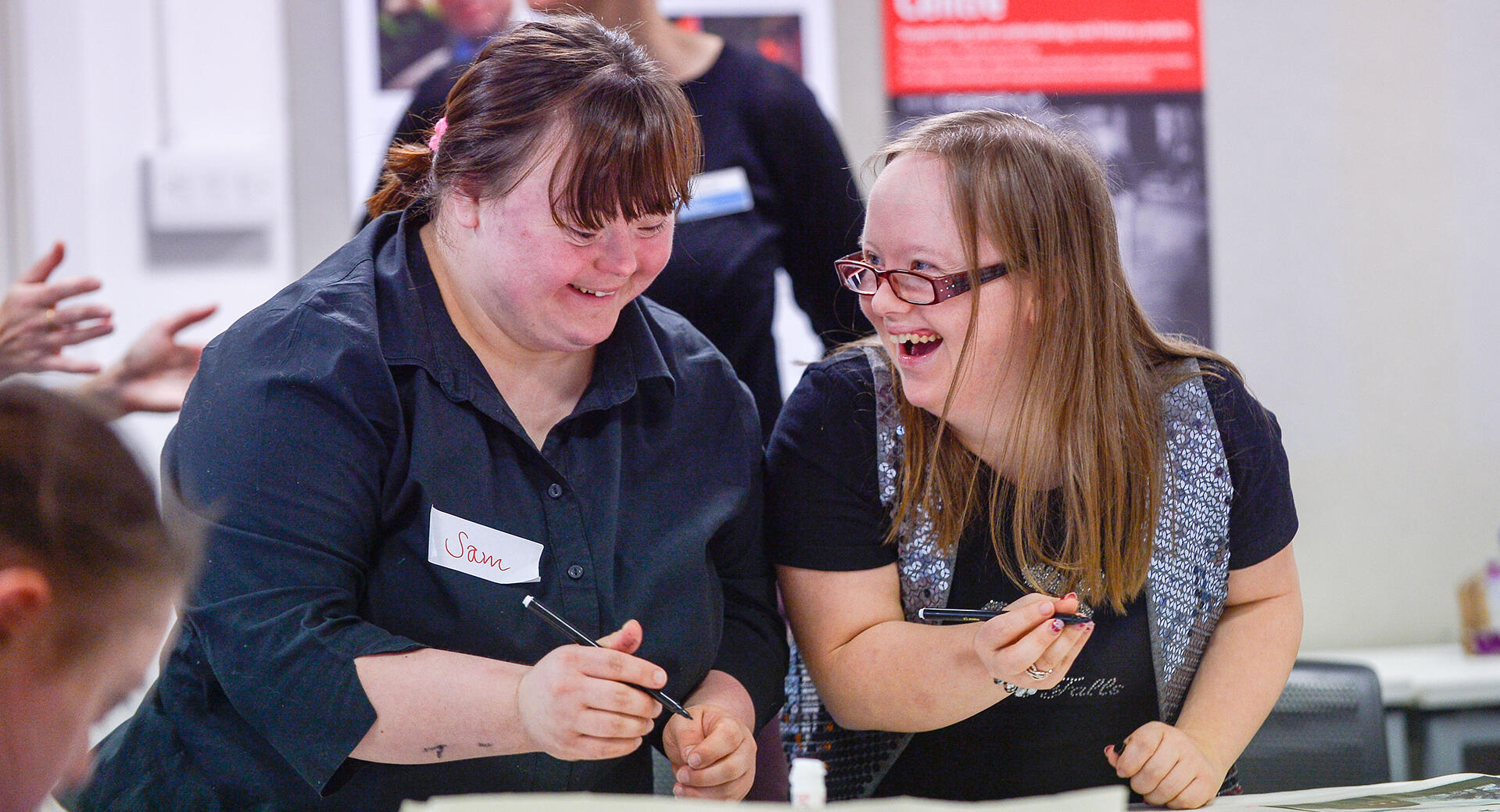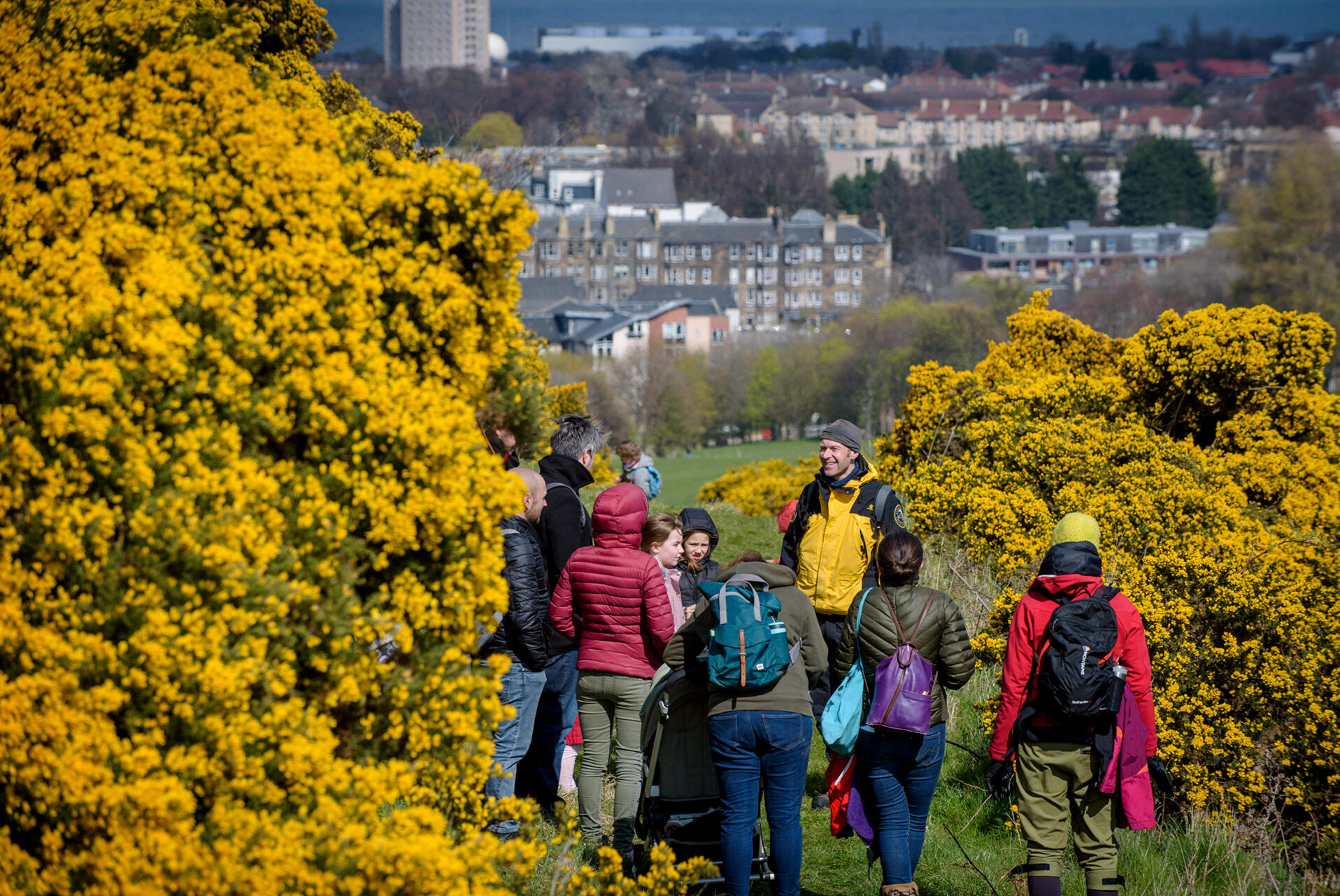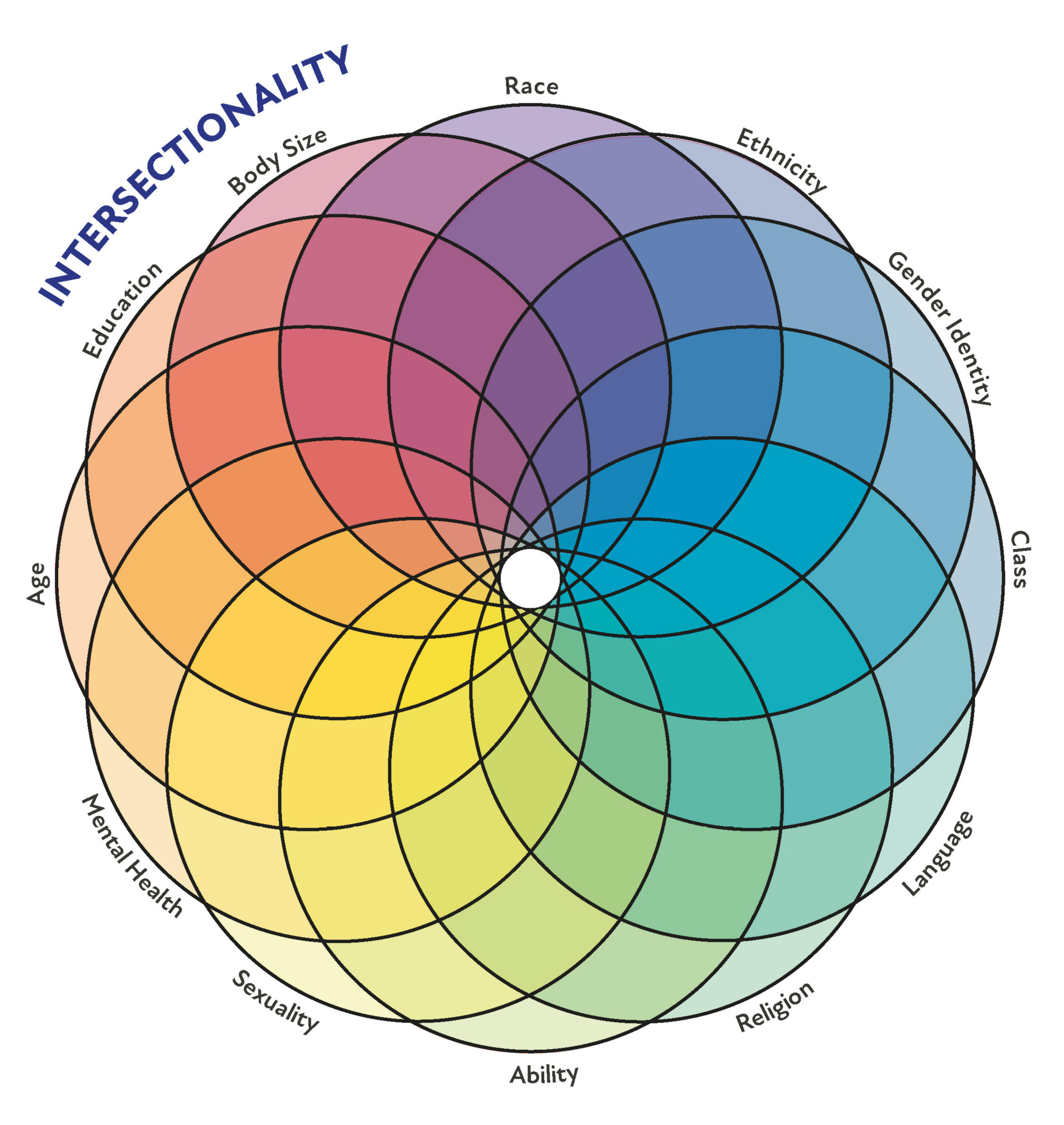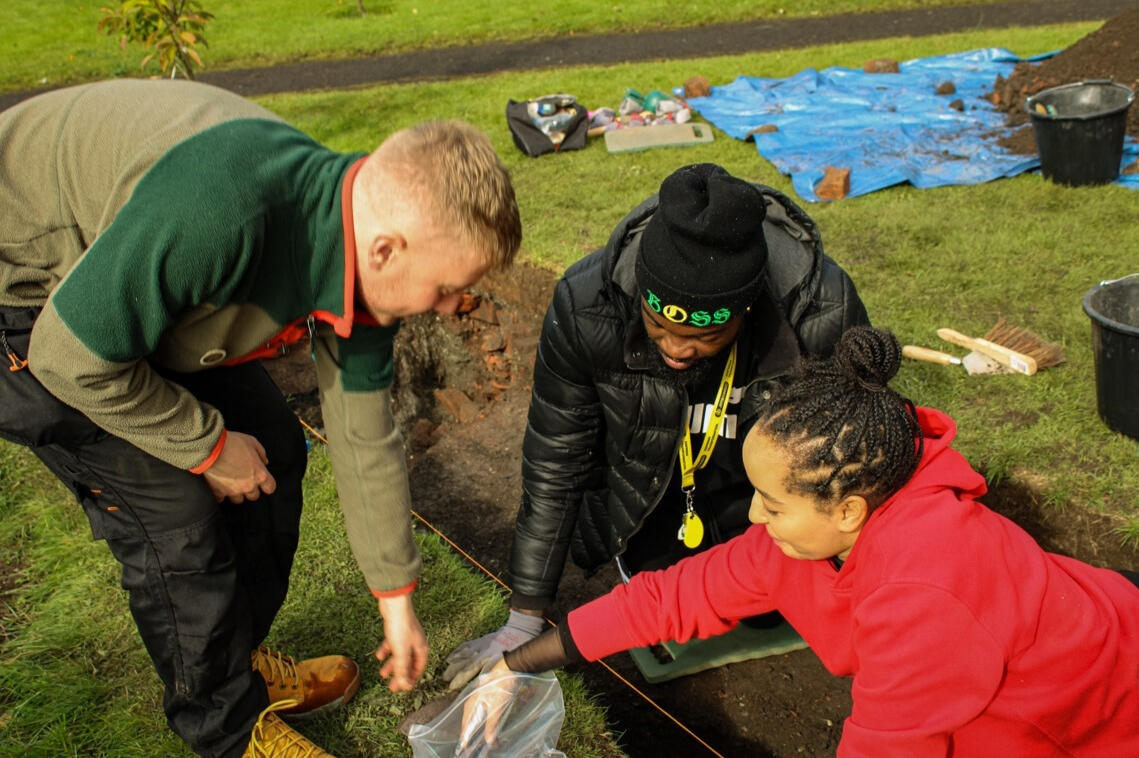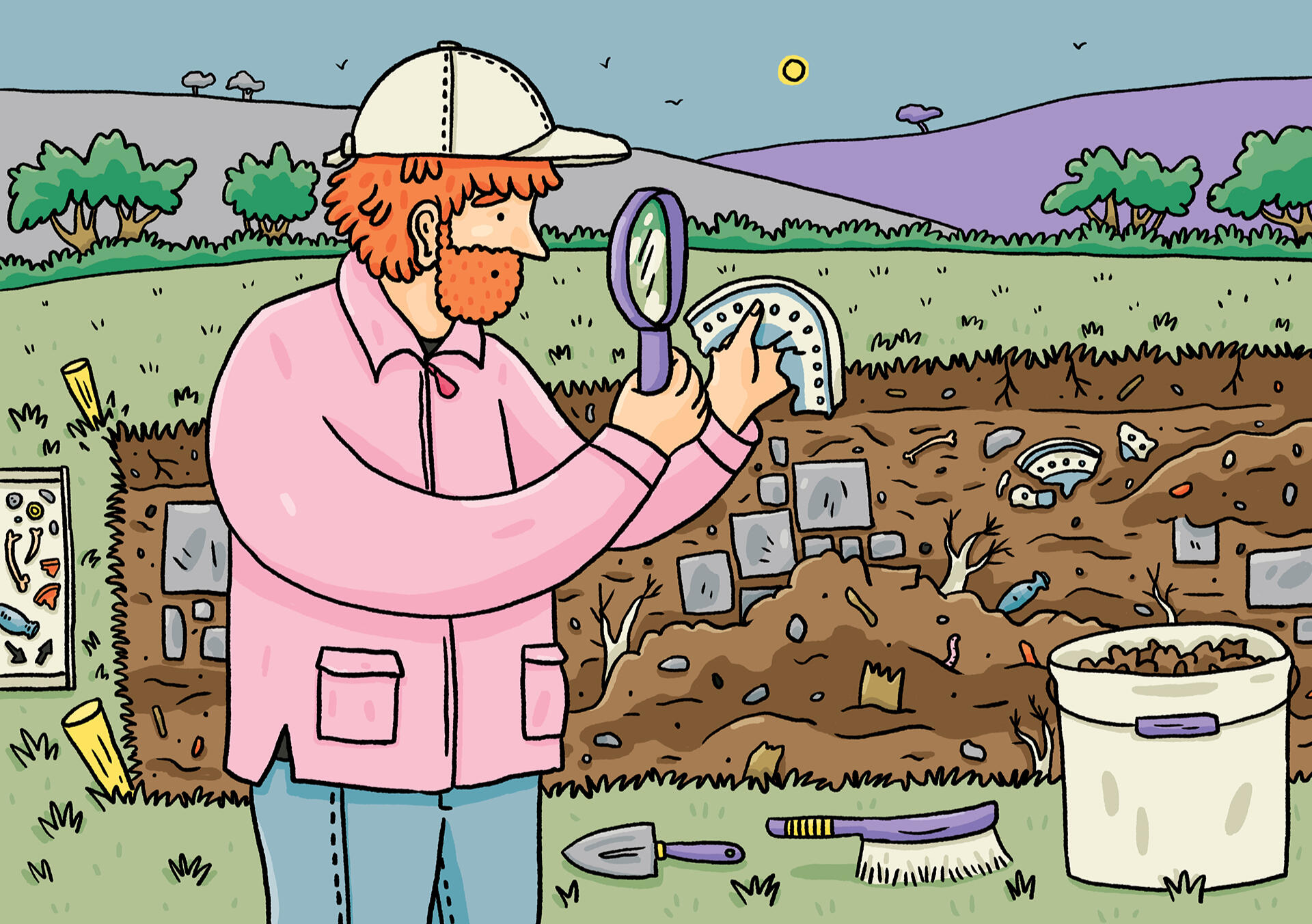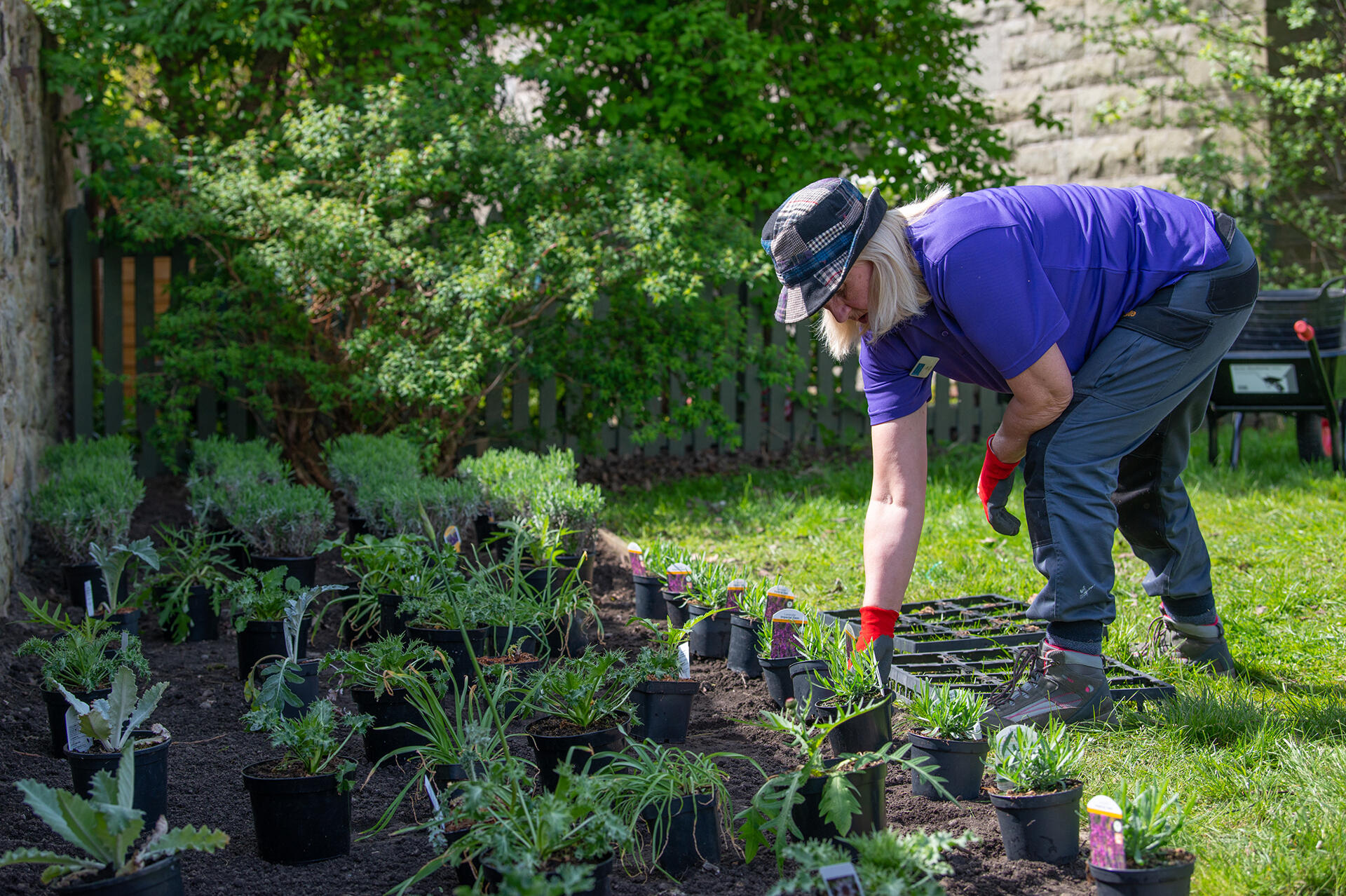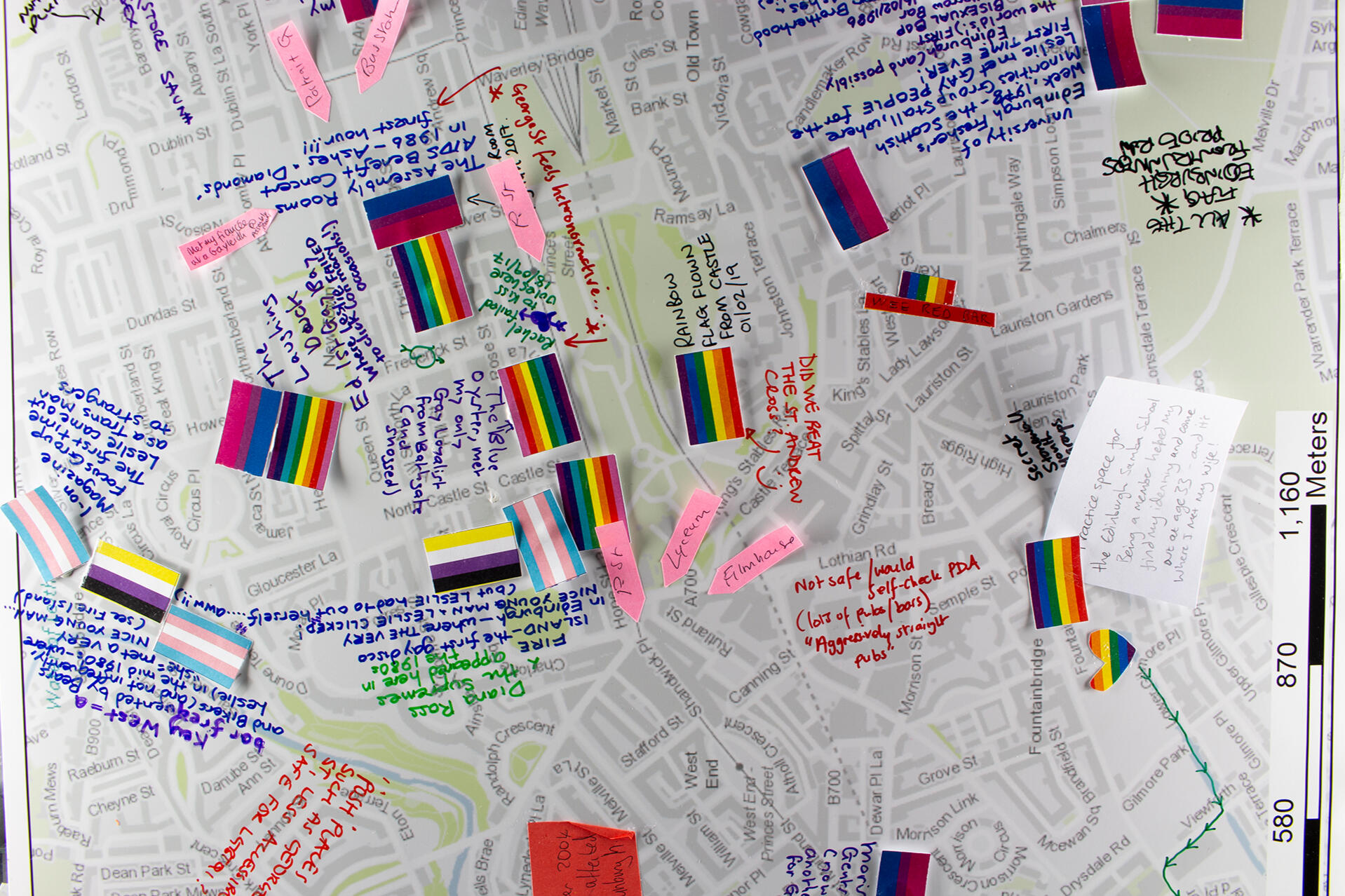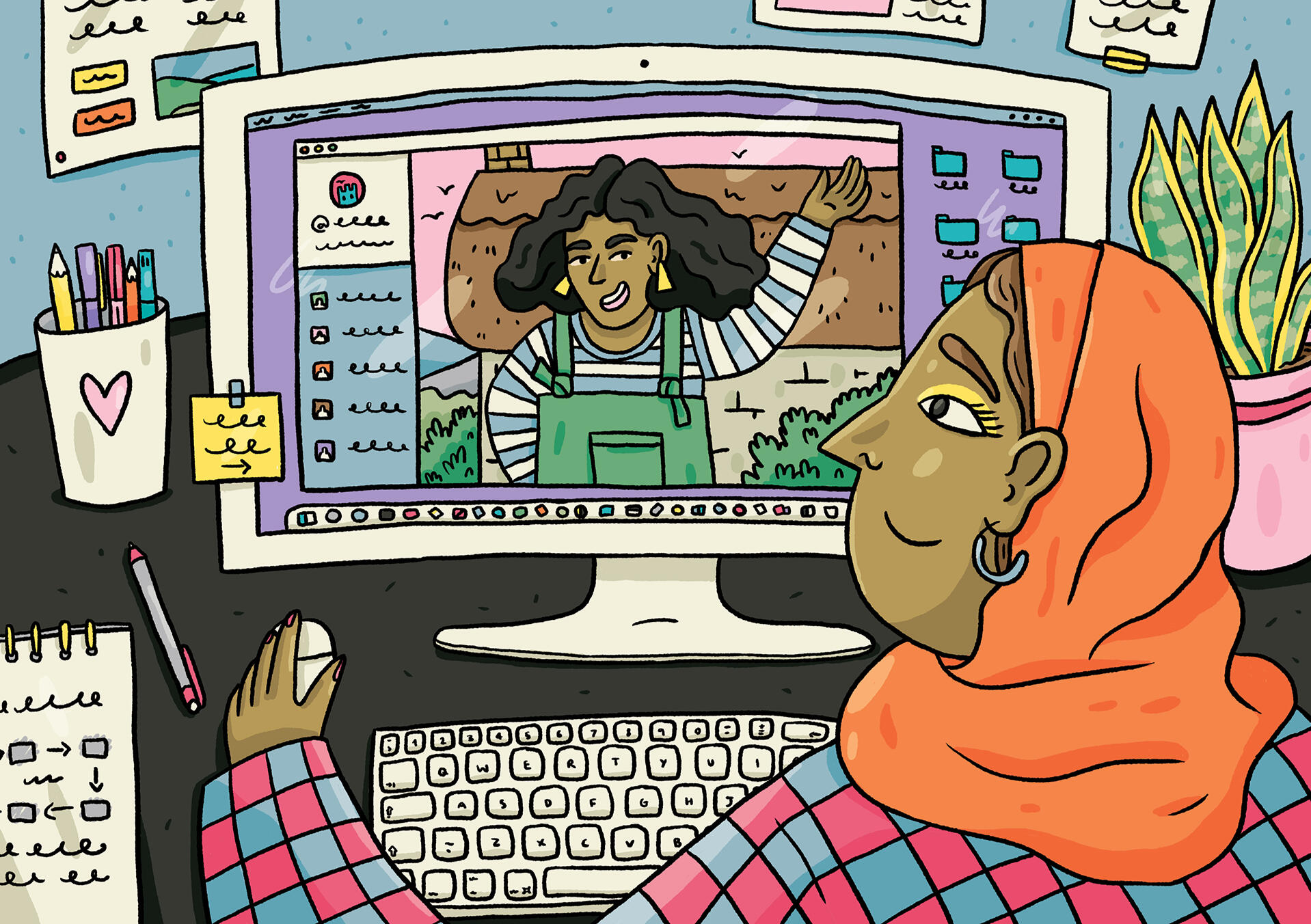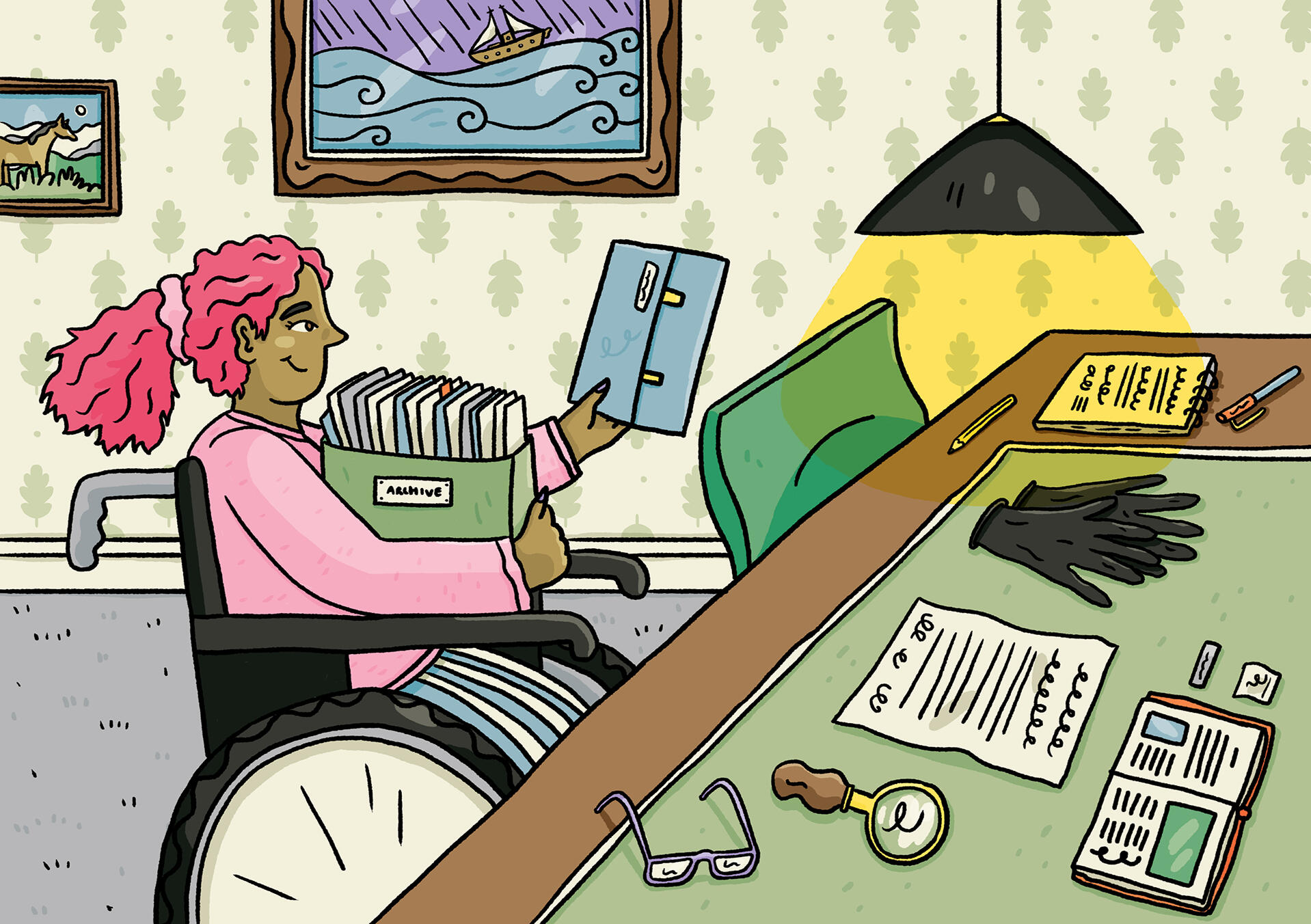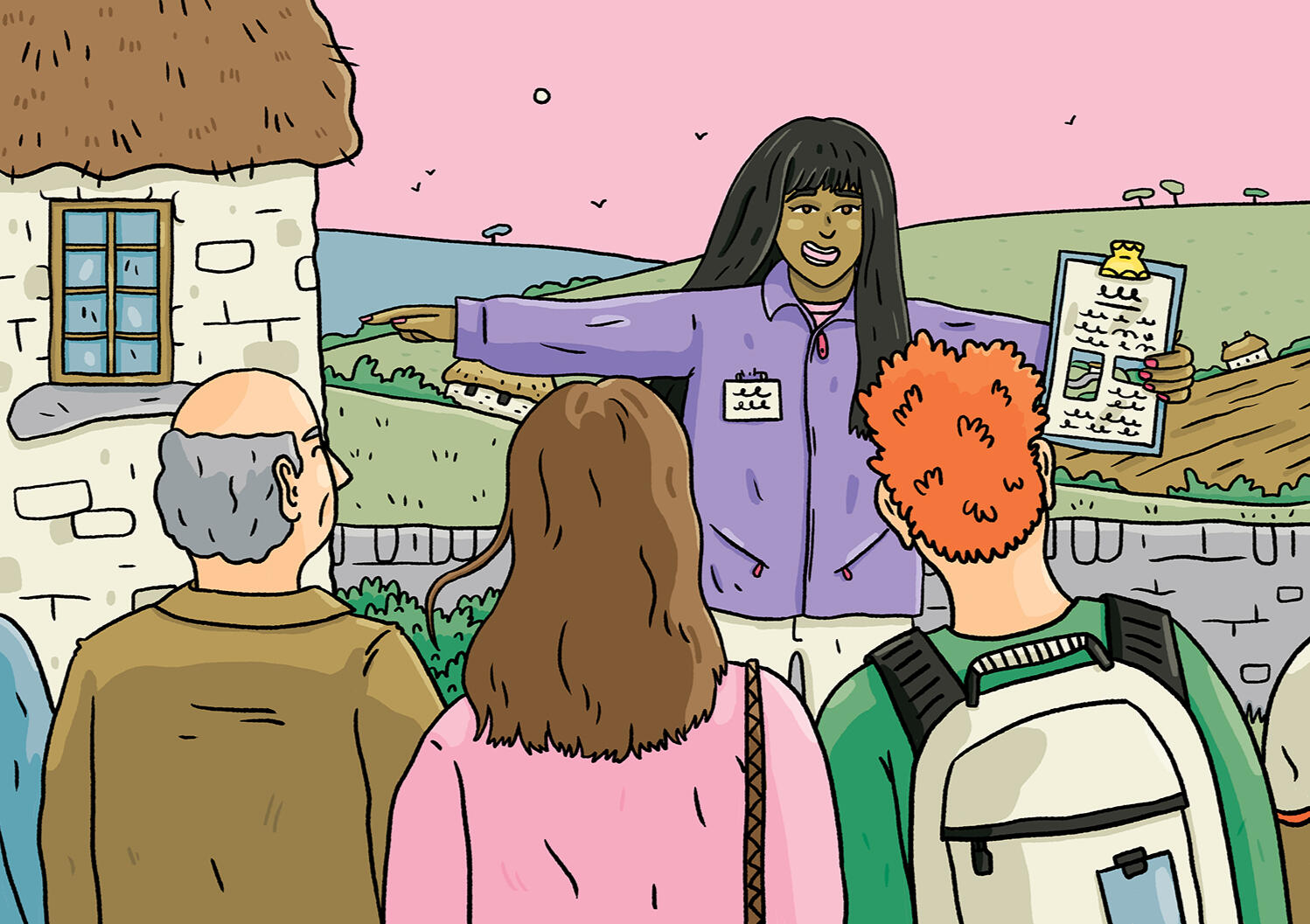Inclusive Volunteering
Toolkit
Navigation
V.2
Updated January 2025
This toolkit and report are the result of a project in 2022/23 supported by the Scottish Government as part of Scotland’s Volunteering Action Plan.Make Your Mark is an ongoing campaign to make heritage volunteering for all in Scotland. It was created in 2020 as part of Our Place in Time, Scotland’s first national strategy for the historic environment.Download a PDF version of the toolkit and a PDF version of the report.
The team behind this toolkit
Yvette Taylor is a Professor in the School of Education, University of Strathclyde researching gender inequalities, LGBTQ+ life and social class. Yvette holds a Royal Society of Edinburgh (RSE) Personal Fellowship (2023-25) on Queer Social Justice.Churnjeet Mahn is a Professor in the School of Humanities, University of Strathclyde researching migrant communities and LGBTQ+ life. She has worked on Equality, Diversity and Inclusion (EDI) initiatives in the Scottish heritage sector.Erin Burke is the Campaign Coordinator of the Make Your Mark campaign. They have a background in community engagement and inclusive heritage practice.Jeff Sanders is the Project Manager for Dig It! at the Society of Antiquaries of Scotland. He holds a doctorate in archaeology and his professional experience focuses on engaging new audiences with heritage.
Additional Thanks
Graphic Design, Website, Accessibility. Brian Tyrrell, Stout Stoat Press.
Illustrations and Photographs. Saffron Russell, Julie Howden, and Helen Pugh. Thanks to Archaeology Scotland, Historic Environment Scotland, Scottish Civic Trust, David Livingstone Birthplace, Glasgow Women’s Library for additional photos.
First Published 2023. Updated 2025.
This work is licensed under the Creative Commons Attribution 4.0 International License. To view a copy of this license, visit:
creativecommons.org.
produced in partnership with


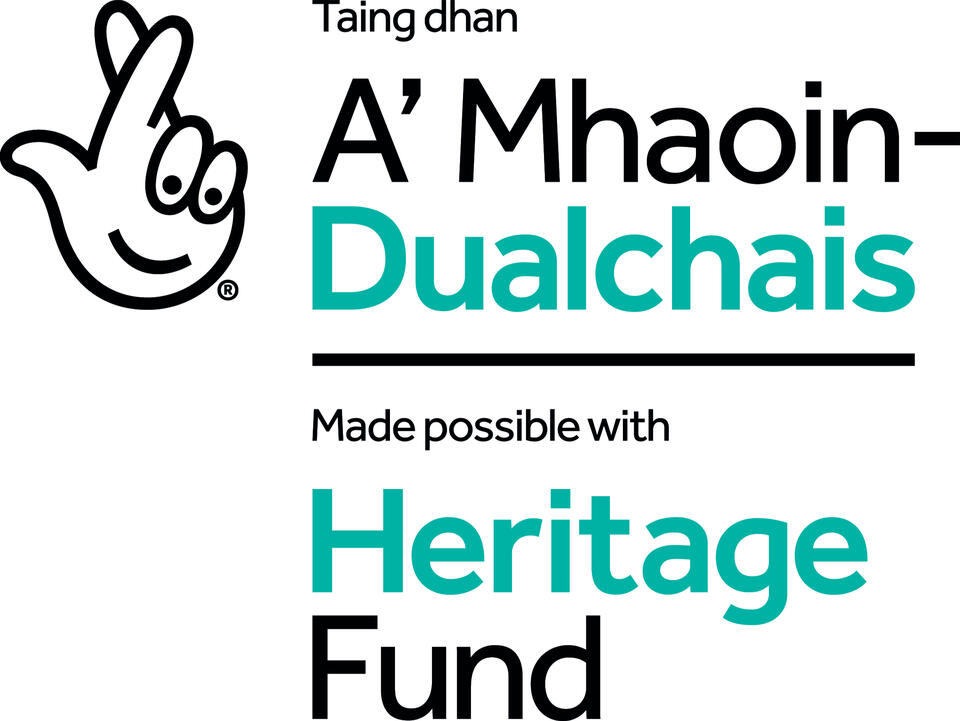
Contents:
Inclusive Volunteering Toolkit
All links lead to content on this website.
8a. Process
About This Toolkit
This toolkit is designed to support voluntary organisations in Scotland to make their volunteering programmes more inclusive.
Background
This toolkit is the result of a project in 2022/23 supported by the Scottish Government as part of Scotland’s Volunteering Action Plan. Further information on the research that informed this toolkit is available for download in a full project report.Conducted across 2022-23, the project aimed to investigate the accessibility and inclusivity of volunteering in Scotland, and how barriers to volunteering could be removed.The toolkit has been designed in response to data generated by a survey of Make Your Mark members (52 respondents from a variety of large, medium and small volunteer-involving organisations across Scotland) and 4 focus groups composed of volunteers and people interested in volunteering.The survey focused on attitudes and approaches to different aspects of diversity and inclusion in volunteering, especially how positive change can be measured.The focus groups gathered the views of a diverse range of participants which highlighted barriers and opportunities for migrant, asylum-seeking, refugee, and BAME communities, disabled people, and people in formal education. Collectively, the groups also highlighted barriers for LGBTQ+ volunteers, older volunteers and issues related to social class1.Drawing on this data, and the existing experience of the Make Your Mark membership in the form of case studies, the toolkit offers practical steps to enhancing inclusion and diversity in the volunteering sector in Scotland.This toolkit is regularly updated to reflect changes in best practice and highlight new case studies and resources about inclusive volunteering. It was most recently updated in January 2025.
1. For definitions of key terms, please see the glossary at the end of this toolkit.

Illustration Credit: Saffron Russell.
How to use this toolkit
This toolkit includes information and guidance on inclusive volunteering, as well as a series of reflective exercises and challenge-framed questions.
It is recommended that all readers begin with reviewing and completing the reflective exercises within sections 1 and 2 to establish an understanding of the current voluntary sector in Scotland and barriers to volunteering. Readers should then complete section 3, which will help them reflect on inclusion individually and within their own organisation.
This is a reflective exercise

These exercises and questions are designed to be undertaken by small groups (3-5 people) combining staff at volunteer organisations (or volunteer coordinators) and volunteers.Subject to capacity, they can also be used by individuals to reflect on their own practices and challenge their thinking.
Readers can then proceed through the rest of the sections chronologically, or have the option to choose which topics within sections 4 through 6 are applicable to their organisation’s volunteering challenges and priorities. This flexible approach to the toolkit recognises that each organisation will be at different stages towards building an inclusive volunteering programme, and have different staffing, structures and budgets for volunteering.
It is then recommended that all readers end with reviewing section 7, and incorporating their learnings from the toolkit into an inclusive volunteering plan for their organisation.
Within each section of the toolkit, further reading and case studies are provided for those interested in specific topics.
An appendix with a glossary and template equalities monitoring form can be referenced at the end of this document.

1. Defining volunteering
What is volunteering?
The Scottish Government’s national Volunteering for All framework defines volunteering as:
"a choice. A choice to give time or energy, a choice undertaken of one’s own free will and a choice not motivated for financial gain or for a wage or salary… it is used to describe the wide range of ways in which people help out, get involved, volunteer and participate in their communities (both communities of interest and communities of place)."
Generally, a definition of volunteering has three components:
1. The activity benefits people outside your immediate family.
2. The activity is unpaid.
3. A person actively and freely chooses to undertake the activity.
Volunteering is commonly divided into formal and informal volunteering. Formal volunteering is when people volunteer through an organisation or group, such as public sector bodies, community councils, local clubs, charities, etc. With formal volunteering, there are usually agreed roles, responsibilities and management arrangements. Informal volunteering occurs on a person-to-person level that is unmediated by a third party organisation, such as helping out a neighbour.

Photo Credit: Historic Environment Scotland.
Volunteering versus placements versus unpaid work
Volunteering is not the same as student placements or unpaid work. Knowing the difference between these ensures that your organisation inclusively and effectively engages volunteers, as well as ensures that your organisation does not violate UK employment law.Student placements are ways for students to gain practical experience as part of an education or training course. It involves a student spending a set amount of time with an organisation to gain experience and fulfill course requirements. There is often a placement contract that sets out expectations for the student, as well as highlights set learning objectives. The student’s performance is assessed by their course leader with input from a designated staff member at the organisation, and in many cases requires the student to complete a project or paper reflecting on their experience. Because a placement is part of coursework required for a qualification, it is not undertaken by choice and is not volunteering. Volunteer Wiki provides more information on the difference between volunteering and internships.When a person volunteers they are choosing to undertake an activity that is unpaid, but volunteering is not unpaid work. According to the Department of Work and Pensions (DWP), unpaid work is undertaking a role that would normally be paid within the private or profit-making sector. Choosing not to get paid for a role that would normally be paid is not volunteering, and the money that a person would normally have been paid for this work may be counted as a person’s earnings.
Volunteer Charter

Volunteer Scotland’s Volunteer Charter is a tool that you can use to underpin good relations within a volunteering environment. It outlines 10 key principles for assuring legitimacy and preventing exploitation of workers and volunteers.Are your volunteer roles in line with the Volunteer Charter? If your organisation is falling short of any of the 10 key principles, what steps can you take to address this? Is your organisation ready to become a Charter Champion?If you’re looking to delve deeper into how your organisation can incorporate the Volunteer Charter into your practices and policies, Open University and Volunteer Scotland have developed a free online course about applying the Volunteer Charter within your organisation.

2. Volunteering in Scotland: Where Are We Now?
Volunteering is a central part of civic life and is most commonly motivated by a desire to make a social contribution or to participate in networks that can enhance a sense of belonging and purpose. This section of the toolkit reviews current data on inclusive volunteering in Scotland.
COVID-19 and the cost of living crisis are two recent examples of forces that have had a negative impact on third sector finances, but which have also underlined the importance of the third sector, especially volunteering, in ensuring the sustainability of public life and services across communities (Scottish Third Sector Tracker, 2024).
The Scottish Government’s Scottish Household Survey (2023) found that:
18% of adults took part in formal volunteering in February 2023 to February 2024. This is four percentage points lower than the 2022 figure (22%) and eight percentage points lower than pre-pandemic levels (26%). Volunteer Scotland’s report on the 2023 SHS results has attributed the decline in formal volunteering to the cost of living crisis and the pressure this puts on people’s time and ability to make a living.
Female formal participation rates remain higher than males (20% vs 17% respectively).
Disabled adults were less likely to volunteer than non-disabled adults (16% versus 19%). However, volunteer participation rates decreased more for people without a disability than for people living with a disability (a decrease of four percentage points compared to only one).
Adults aged 35-59 have the highest formal volunteer participation rates of 20%. Younger adults in Scotland (aged 16-34) have the lowest formal volunteer participation rates for the second consecutive year (16%).
The ethnic group with the highest volunteer participation rate is ‘white-other British’ (27%). Adults in the ‘minority ethnic’ group have a participation rate of 22%. The volunteer participation rate for white Scottish adults is 21%.
People living in the 20% least deprived areas of Scotland are more likely to volunteer than those from the 20% most deprived areas (24% versus 12%). However, the gap has decreased by two percentage points from 2022 and five percentage points from 2019.
Those living in rural areas have a higher volunteering participation rate (23%) compared to the rest of Scotland (17%).

Photo Credit: Glasgow Women’s Library.
Volunteer Scotland’s Report on Volunteering Trends in Scotland (2022) has shown that in Scotland you are more likely to volunteer if you are:
Female
Non-disabled
Aged 35 to 59
White
Living in the least deprived areas of Scotland
Retired
Living in a rural area
This toolkit is designed to help volunteer organisations think about how to distribute the value, opportunities and benefits of volunteering across the whole of Scottish society.
Inclusive volunteering in Scotland

Does this data surprise you or not? Discuss your responses.Have there been changes to who volunteers and why over the past 3-5 years in your organisation? If so, why do you think this has happened?Do you think everyone in society should have equal opportunities to volunteer or is it better suited for particular groups of people? Discuss why.What’s the data or information about volunteering that you’d like to know but don’t have (e.g. average hours of volunteering, or number of disabled volunteers)?
What is Equality, Diversity and Inclusion?
Equality, Diversity and Inclusion (EDI) has provided a framework for many organisations to address cultures of inequalities. One frequent criticism of EDI policies is that they can encourage a culture of ‘box ticking’ where there are token changes without challenging underpinning norms in an organisation.In this toolkit, we define:
Diversity as attributes which reflect the make-up of society (e.g. race, ethnicity, class, gender, sexuality, disability, faith, etc).
Inclusion as a values-driven practice to create a diverse, open and welcoming environment which is evidenced through concrete commitments and action.
The Equality, Inclusion and Human Rights Directorate at the Scottish Government identifies priority areas for inclusion work, which covers, and goes beyond, protected characteristics.
Case Study:
Creating an Equality, Diversity and Inclusion Policy

Glasgow Women’s Library has developed an Equality, Diversity and Inclusion Policy to ensure that in carrying out its activities, the organisation will have due regard to promoting equality of opportunity, diversity and inclusion across the organisation, promoting good relations between people of diverse backgrounds, and eliminating unlawful discrimination.

Photo Credit: Julie Howden.
Why is inclusion a particular issue for the voluntary sector?
Volunteering is a key way to develop new social networks and skills which can help with employment. The value of volunteering is most likely to have a transformational social and economic impact on individuals and communities which experience marginalisation. However, these individuals and communities are also more likely to experience:
Financial barriers to participating in volunteering (from childcare to requirements for paid work).
Information barriers to learning about volunteering (from language to regular venues for advertising opportunities).
Social and cultural barriers to volunteering (from a lack of diversity amongst existing staff and volunteers to imposter syndrome).
Access barriers to participating in volunteering (from access to screen readers to a willingness to support disabled volunteers).
Key reasons inclusion initiatives fail or have limited success include:
Narrow and limited applications of diversity initiatives which lack ambition and do not effect long-term change (e.g. isolated recruitment of volunteers who count as ‘diverse’ without any dedicated support for the individuals).
A resistance to acknowledging inequalities in organisational culture(e.g. tackling entrenched inequalities relating to gender, disability or race).
A lack of resources, skills or knowledge (e.g. organisations expressing a lack of confidence to address equality issues).
A commitment to inclusive volunteering involves taking meaningful action to create equal and diverse access to the personal, social and economic benefits of volunteering. This toolkit has links to a range of resources and expertise in the sector; you are not alone!Make Your Mark also continues to offer dedicated support, especially in fostering smaller communities of practice.
It’s important to recognise that there are a range of organisations working on developing inclusive volunteering opportunities. Challenges include:
Financial resources and capacity to deliver inclusion-focused initiatives, especially for smaller organisations.
Worries about ‘language’ or terminology and ‘getting things wrong’ with inclusion work.
Not knowing where to start, or how to know inclusion initiatives are working.
Inclusion in the voluntary sector

What are the most important values in your organisation?
Are you surprised by any of the categories on the Equality, Inclusion and Human Rights Directorate’s list of priority areas for inclusion?
How do you promote a culture of inclusion? What works best in practice? What do you think needs more work?
What are the challenges and opportunities for doing diversity and inclusion work in smaller versus larger organisations? Is it easier to change a culture in a smaller organisation or a big one?

3. Understanding Barriers to Volunteering
Potential volunteers may face various barriers that could dissuade or prevent them from volunteering. This section of the toolkit identifies possible barriers to volunteering, including economic, social, cultural and physical barriers.
Economic barriers
to participation
Economic barriers to volunteering are becoming more prevalent due to the cost of living crisis. Volunteer Scotland’s quarterly Cost of Living bulletins track the impact of the crisis on volunteering, with many voluntary organisations experiencing increased demand, rising costs and stagnating income, decreasing their capacity to involve volunteers. Prospective and current volunteers also have less time and money, which has negatively impacted many people’s mental health, decreasing people’s capacity to volunteer.In this economic context, it becomes more critical for organisations to include a substantial budget for inclusively engaging volunteers within funding bids. More information about how to do so and what sorts of costs to consider can be found in section 6.
Examining barriers
Potential volunteers may face some of the following economic barriers to volunteering with your organisation:
Childcare costs

Some volunteers may have childcare responsibilities, and need to pay for childcare cover whilst they volunteer.
Reflective exercise: What practical support can your organisation provide to support volunteers with childcare costs? If this is limited, how could it be fairly allocated? If it’s not available, are there other flexible opportunities for volunteering? Is it possible to learn from best practice in the past or from other organisations?
Time

All volunteer roles require people to give their time, but some people may need to work long hours to make ends meet, have childcare or other responsibilities, and thus have a lack of free time.
Reflective exercise: What is the future potential for flexible volunteering opportunities?
Travel expenses

Some volunteer roles are in-person rather than online. Some volunteers will have to access transport, which can be prohibitively expensive.
Reflective exercise: What practical support can your organisation provide to support volunteers with transport costs? If this is limited, how could it be fairly allocated? If it’s not available, are there other flexible opportunities for volunteering?
Equipment costs

Some roles require equipment (computers, wifi, uniforms, tools) to be undertaken.
Reflective exercise: Is there a way of supporting access to equipment through pooling resources with other organisations or having an equipment bank? How could this information be made available to potential volunteers?
Disclosure costs

Some roles require disclosure checks, which cost money and may discourage people with convictions or experiences of being unhoused from applying to volunteer.
Reflective exercise: Can you use Volunteer Scotland’s free Disclosure Services? If not, Is there an annual budget to support disclosure costs? How could this be fairly allocated to potential volunteers?
Benefits & Rights to Work

Some people who receive UK State benefits or who are seeking asylum may not be aware that volunteering will not affect their benefits or status, and may be nervous about volunteering.
Reflective exercise: Do you have the knowledge and skills in your organisation to offer basic information or signposting to support anyone in this position?
Food & drink

Some people who volunteer may be giving up time that they’d otherwise use to earn money to pay for food and other needs.
Reflective exercise: Are there forms of material support (e.g. community and team building meals) that could be developed at your organisation?
Social & cultural
barriers to belonging
Although volunteer programmes may encourage everyone to apply, attitudes, assumptions and previous experiences may prevent people from getting involved. Each sector of volunteering has some common assumptions about what a typical volunteer looks like.
For example: There is a perception that museum volunteers are typically white and middle-class, and that many have degrees or qualifications. Some potential volunteers may think that it would be difficult for someone without qualifications or a good knowledge of history to volunteer in a museum.
Challenge: To what extent do you think this perception of museum volunteers is true? Who is considered the ‘typical volunteer’ within your sector or organisation?
Examining barriers
Potential volunteers may face these social and cultural barriers to volunteering with your organisation:
Experiences of structural discrimination: Experiences of racism, for example, can reduce faith in the willingness of white-led or white dominated organisations to support and value diversity.
Case study: Recognising racism in volunteer engagement. The Black Lives Matter Protests of 2020 renewed calls for racial justice and systemic change. In this case study on recognising racism in volunteer engagement, Faiza Venzant, Executive Director of the Council for Certification in Volunteer Administration, identifies and dismantles the structures, policies and processes that are built upon white supremacy culture.
Lack of confidence: Everyone has useful and valuable skills and experiences, but some people may have had negative experiences where they were made to feel undervalued or unqualified in society. This is commonly experienced by marginalised groups (e.g. because of their disability or race).
Ideas about what ‘volunteering’ means: Many communities have informal types of voluntary work (e.g. religious service or ‘helping neighbours out’). This is very common in working-class, migrant, disabled and LGBTQ+ communities.
Reflective exercise: Is there anything volunteer organisations can learn from these informal volunteering models and vice versa?
Attitudes and assumptions amongst staff in volunteer organisations: The lack of diversity within volunteer organisations can lead to gaps in knowledge and lived experience, resulting in stereotypes and discriminatory views going unchallenged.
Reflective exercise: If you have tried to diversify the profile of volunteers in your organisation, has it worked? If you haven’t tried an inclusion and diversity initiative, are there 1-2 things your organisation could do differently to help remove barriers to participation?

Photo Credit: Helen Pugh.
Physical barriers to access
The site or building that people volunteer at can be a barrier to volunteering. There can also be physical barriers preventing volunteers from getting on-site.
Transport: The accessibility or availability of public transport links can make it difficult for some volunteers to get on-site to volunteer. This is especially true in rural areas.
Exterior elements: Physical barriers can prohibit people from entering your site, and may include things like parking areas, kerbs, paving, steps and doors.
Interior elements: Physical barriers can also prohibit people from moving around your site, having their basic needs met or engaging with the volunteer role. This includes things like stairways, doors, toilets and washing facilities, lighting and ventilation, lifts and escalators, floor coverings and signs.
Case study: Rural volunteering. The Royal Zoological Society of Scotland has recently opened several new facilities at their Highland Wildlife Park. As part of the redevelopment project, they’re also developing a new and improved volunteer programme in the heart of the Cairngorms. In this case study on rural volunteering, they share their successes as well as lessons learnt.
Reflective exercise: What elements of your site could you alter to increase accessibility? If you don’t have the budget to change all inaccessible elements, how do you prioritise what to change first? If you can’t alter certain elements of your site because of planning or structural restrictions, can you offer adapted roles that can be completed online or elsewhere?

4. Reflection on Inclusion in Volunteering Organisations
Each individual and organisation will be at different stages in developing awareness about equality, diversity and inclusion. This section of the toolkit will help you reflect on your own experiences and your organisation’s practices to identify areas for growth.
Reflecting on your own experiences
Everyone has different backgrounds, identities and needs that shape our position in and understanding of the world. It can be helpful to think through your experiences and how they impact you. There are several self-guided tools that can help:
The Privilege Walk helps people to become aware of the various privileges they might possess.
The Intersectionality Wheel helps people to visualise how various privileges interact and compound.
Power and privilege are two interconnected terms. They have become useful ways to conceptualise the everyday hurdles some people face when navigating daily life.For more guidance on terms related to equality, diversity and inclusion, please see the glossary at the end of this toolkit.
Privilege walk

What are the different kinds of power and privilege in your group? Are they the same? Different? Can you discuss how they shape your experience and viewpoints?
The Intersectionality Wheel is reproduced from designs by Sylvia Duckworth.
“Intersectionality is a lens through which you can see where power comes and collides, where it locks and intersects. it is the acknowledgement that everyone has their own unique experiences of discrimination and privilege.” - Kimberlé Crenshaw.
Expanding intersectionality

What other forms of power can you think of that impact members of your community?
Where is your organisation in the inclusion journey?


1. Groundwork
Does your organisation have the necessary skills and knowledge to implement NCVO’s recommendations for Equality, Diversity and Inclusion? Does your organisation collect data about the current diversity of volunteers?

2. Induction
Do your induction processes contain information that signposts support for diverse communities of volunteers?

3. Listening
Do volunteers feel that their views and voices are equally valued? Is there a culture where volunteers can report problems and have confidence in concerns being addressed?
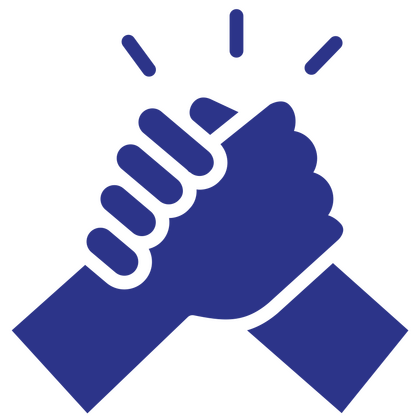
4. Supporting
Are a range of mechanisms in place to acknowledge different volunteers need different kinds of support?
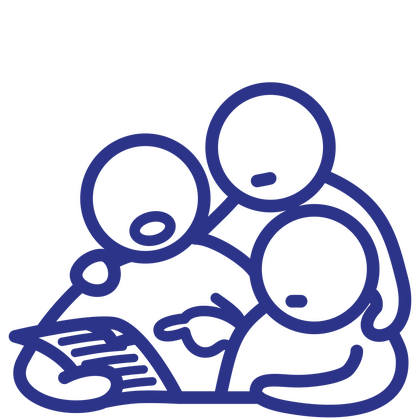
5. Reflection
Is there space to critically think with volunteers about what could be done differently or better?

6. Acting
Is a clear inclusive volunteering plan in place to address any issues relating to wellbeing, safety and/or discrimination? Have they been tested or used? Have they been proven to work well?

7. Learning
Can you document and record areas of best practice and learning to share with other voluntary organisations?

8. Evaluation
Do you combine qualitative and quantitative mechanisms to evaluate success?
Inclusive volunteering at your organisation
Based on your answers to this exercise, how would you rate where your organisation is in its inclusion journey from from 1-8 (where 1 is not started and 8 is highly developed)?
What areas do you need to work on?

5. Governance and Policies
The work of inclusion can too easily focus on siloing diversity into a problem for one part or department of the organisation, such as outreach, education or community engagement. Having expertise in inclusive governance and policies can be an important step forward in bolder, all-organisational approaches to equality and representing the society we live in. This section of the toolkit gives advice for inclusive governance policies and practices.
Leadership
To be truly transformative, inclusive policies and practices should be embedded in an organisation’s leadership. The most effective boards have a diversity of individuals with varying backgrounds and experiences, which ensures that issues are debated and understood from varying points of view.
Despite this, the Charities Inclusive Governance Report (2022) found that:
“The UK’s largest 500 charities’ senior leadership teams and boards remain unrepresentative of the people they serve and employ.”
Only 13% of charity boards had gender parity, and 29% of boards were all-white. For boards of organisations on the Financial Times Stock Exchange (FTSE) 100 Index, which are companies in with the highest market capitalisation, only 4% had all-white boards, demonstrating the market power of board diversification.
Getting On Board’s Practical Guide to Diversifying Boards takes you through the steps of how to approach the subject of changing your board composition with your existing trustees and chair. For further guidance, you can access Open University and Volunteer Scotland’s free online course about how to develop leadership practices within voluntary organisations.
Inclusive governance

Are the most senior/influential leadership teams in the organisation diverse?
Is there a commitment to diversity amongst the senior/influential leadership teams? If so, how is this demonstrated in action? Please think of 2-3 examples and how they work in practice.
Case study: Amplifying the voices of refugees and asylum seekers in decision making.

Involving refugees and people seeking asylum on boards can be mutually beneficial for the organisation and volunteers. In this case study on supporting refugees and asylum seekers to join boards, the Mental Health Foundation talks about how their Elevate and Beyond Visibility programmes have empowered and supported refugees and asylum seekers to join boards.
Policies for volunteers
While many organisations have policies that help protect and support employees, they do not always have policies to protect and support volunteers.Consider the use of the following policies and processes for volunteers:
Equal opportunities statement: NCVO has developed a template equal opportunities statement for voluntary organisations in the UK.
Volunteer agreement: Volunteer Scotland has developed a template volunteer agreement, which makes it clear what the volunteer can expect from the organisation and what, in turn, the organisation expects from the volunteer.
Volunteer policy: Volunteer Scotland has developed a template volunteer policy, which outlines clearly to all staff, volunteers and audiences why volunteering is needed.
Grievance / complaint process: Volunteer Scotland provides guidance on managing challenging situations with volunteers.
Feedback and evaluation processes: Volunteer Scotland provides guidance on measuring the impact of volunteering.
Inclusive volunteering policies

Is your organisation confident it could support diverse volunteers through these policies?
Example: A volunteer experiences a racist incident involving another volunteer. They have raised an informal grievance with their organisational contact, but do not want to make it official as they are afraid of what might happen next and feel traumatised by the incident.
What would your organisation do in this instance?

6. Inclusive Volunteering Steps to Positive Action
Volunteer organisers can take a variety of steps to develop meaningful and accessible volunteering opportunities for everyone. This section of the toolkit gives an overview of how to remove barriers to volunteering. The final topic of this section is an inclusive volunteering checklist that you can use to assess what facilities and services you can offer to be more inclusive.
Centring the voices and
experiences of volunteers in Scotland
Centring a diverse volunteer voice in the development of volunteer policies, procedures and opportunities is key to ensuring that your volunteer programme is accessible, inclusive, relevant and fulfilling for everyone.
Surveys
You could partner with a community group to survey their members about their perceptions and experiences of your organisation and volunteer programme.You could ask:
Have you heard of our organisation? If so, where/how?
Have you visited our site or participated in our events? Why or why not?
Did you know you could volunteer with us?
Have you considered volunteering with us before? Why or why not?
What would you want to get out of volunteering with us?
How could we make our organisation and volunteer roles more accessible, relevant or interesting to you?

Photo Credit: Archaeology Scotland
Focus groups
Another method you could use to better understand marginalised people’s perceptions and experiences of your organisation and volunteer programme is to host focus groups.
Our top tips for organising focus groups are:
Partner with organisations that engage with marginalised audiences. These organisations are best placed to understand their audiences’ needs, help you organise an accessible space and advertise the session to participants.
Ensure that you have everyone’s informed consent. Adapt NCVO’s template consent form to draft a basic consent form outlining the purpose of the focus group.
Frame the approach as an open discussion. Some focus group participants may be worried about offending a representative from your organisation. Be clear that the session is an open discussion, every experience is valid and there are no wrong answers. You could also consider hiring an external facilitator or partnering with a local equality council to help facilitate the sessions.
Establish caretaking practices and procedures. Some participants may talk about distressing instances of racism, sexism, homophobia, ableism and/or classism that they experienced whilst trying to visit a site or participate in a volunteer opportunity. Prepare a list of organisations and resources that participants can access for additional support should they need it. You should also make it clear to participants that they can take a break or leave at any time, and do not have to answer any questions they don’t want to.

Illustration Credit: Saffron Russell
Recruiting volunteers
There are several examples of inclusive recruitment best practice that the volunteer sector can draw on, such as:
The following information provides suggestions based on feedback from focus groups with potential volunteers from diverse backgrounds.
Sharing volunteer stories
Having your current volunteers share their stories can encourage people to try out volunteering by giving more information about roles and the benefits of volunteering. Content created by volunteers, also called user-generated content, is 10 times more trusted than content produced by organisations themselves, so it’s a powerful marketing tool.
You could share blog posts or videos with your volunteers talking about:
1. Their role and the tasks they undertake.
2. Why they were interested in volunteering.
3. Their favourite volunteering experience.
4. How volunteering has impacted their life.
Case study:
Sharing volunteer stories

Make Your Mark shares blogs and videos of heritage volunteers detailing their experiences of volunteering and why they love to volunteer.
Taster sessions
Taster sessions are informal ways for people to learn more about an organisation or volunteer role ahead of applying. They can help to alleviate any questions or concerns that people may have about volunteering.
During the session, it can be helpful to introduce the day by covering:
What your organisation does.
The benefits of volunteering.
What volunteer roles are available.
Any questions that volunteers may have.
People could then choose the role most interesting to them and break into groups to complete a small task associated with the role. After 20 minutes, groups could switch roles so people can try out a few different types of tasks and see what they like.
Shadowing opportunities, like taster sessions, can help potential volunteers get a sense of your organisation and volunteer roles, as well as alleviate any anxieties about volunteering.
Multiple ways to apply
Providing multiple ways to apply to your volunteer opportunities allows people to choose the communication channel accessible or most comfortable to them.
Multiple ways to apply could include:
Emailing a short paragraph about themselves and why they’re interested in the role.
Creating a short video about themselves and why they’re interested in the role.
Arranging a call with the volunteer organiser to have an informal chat about their interest in the role.
Attending a taster session before applying.
Case study:
Inclusively recruiting volunteers

In 2019 and 2020, Historic Environment Scotland reviewed their recruitment processes to make them more inclusive and easy to engage with. In this case study on inclusively recruiting volunteers, read about how they stopped asking for written applications, offered taster sessions, stopped asking for references and more.
Advertising opportunities
Advertising opportunities is a key issue. Developing a proactive plan combining social media (especially targeted at community groups), community radio stations and hubs and events within community settings is a positive step towards reaching ‘out’ to volunteers.
Working in partnership with community organisations is another beneficial vehicle for building trust, especially in resolving issues which may arise later. In your introductory communication to potential partners, you should specify:
1. What your organisation does.
2. What volunteer roles you offer.
3. Why you want to involve a more diverse range of volunteers.
4. What your volunteer programme can offer their members/audiences.
5. What the other organisation could do to support your volunteer programme. This might entail:
5a. Promoting your volunteer opportunities to their members / audiences.
5b. Distributing a survey about your volunteer programme to their members / audiences.
5c. Organising a focus group about your volunteer programme with their members / audiences.
5d. Organising an info session with their members, where you can meet them in a space comfortable to them and give information about your organisation and volunteer programmes.
5e. Their members / audiences visiting your venue and providing feedback on accessibility and inclusion
5f. Their members / audiences providing feedback on policies or role descriptions.
5g. Their members / audiences participating in a volunteer taster sessions to introduce them to volunteering with you and/or to give you feedback on how to be more accessible or inclusive.
Working with community collectives can help to connect volunteering organisations to other socially-driven care groups. Thistles and Dandelions have created a toolkit to help organisations partner with community groups.
If you’re keen to connect with a relevant partner organisation or group, but not sure where to start, Make Your Mark manages a database of organisations in Scotland who work with and represent excluded groups.
Case Study:
Partnering with local groups

To diversify their volunteer programme, the National Galleries of Scotland reached out to local charities and community groups that worked with excluded audiences.
In this case study on partnering with local groups to increase diversity, read about how they approached groups and adapted their opportunities to be more inclusive.

Photo Credit: Helen Pugh.
Flexible opportunities
Especially since COVID-19 and the cost of living crisis, flexible opportunities are a requirement for many people who can’t afford transport or childcare costs involved in volunteering, or have barriers related to health and/or disability. Ongoing innovation in sourcing flexible opportunities will allow more people to consistently engage with the benefit of volunteering.
Asking about volunteers’ needs
Having an open and ongoing conversation about volunteers’ needs is key to making volunteering more accessible. It’s important to avoid making assumptions and speak to each person individually about their needs, as every person has different abilities and has had different experiences.
To foster a culture of open conversation around needs, you could:
Provide detailed accessibility information on all volunteer role descriptions.
Ask volunteers at the application stage if they have any access needs that you should be aware of.
Organise monthly or quarterly catch ups with volunteers to check in and revisit how you can better support them.
Case study: Enabling everyone
to take action for nature

NatureScot supports people from a range of backgrounds to participate in the Scottish Invasive Species Initiative.
In this case study on enabling everyone to take action for nature, read about how they don’t require volunteers to have prior experience, provide free training and offer a range of flexible ways for people to get involved.
Offering adaptations
Once you’ve had a conversation with a volunteer about their needs and circumstances, have a think about how you could change up your practices to support their volunteering. You could:
Reconsider what skills or experiences are actually necessary. Some volunteer role descriptions include things like being personable and friendly, which can exclude people who are looking to volunteer to build their confidence. You may also consider whether volunteers really need any prerequisites to complete your roles, or if they can be trained and supported to do their tasks.
Offer a buddy system or group or family volunteer opportunities. If a person is worried, unsure or anxious about volunteering, you could offer to initially pair them up with an experienced volunteer who can support them. You could also offer group or family volunteering opportunities so that people can try out a new activity amongst the security of friends and family members. The buddy system can also be a great approach for supporting people who are volunteering to improve their English language skills.
Offer shorter shift times. Some people may not be able to stand for long periods of time, or may be living with conditions that cause fatigue. Think about if you could break up longer shifts into shorter periods, or adapt roles so volunteers can complete them whilst seated.

Photo Credit: Historic Environment Scotland.
Communication
The way organisations communicate - the words and images used, tone of voice, format of designs and channels chosen - affect whether they exclude or include a person or a group.
Design
How communications are designed can increase the accessibility of your information. In order to maximise the number of people who can understand your graphic design, consider the following:
Left align your text.
In some languages, like English and Scots, sighted readers are used to reading from left to right, and from top to bottom. Left aligned text is therefore typically the easiest to read because it best follows these expected conventions.
Right align, centred, and justified text is harder to read because sighted readers have to work harder to find the start of each line, and have to process unexpected spacing in-between words.
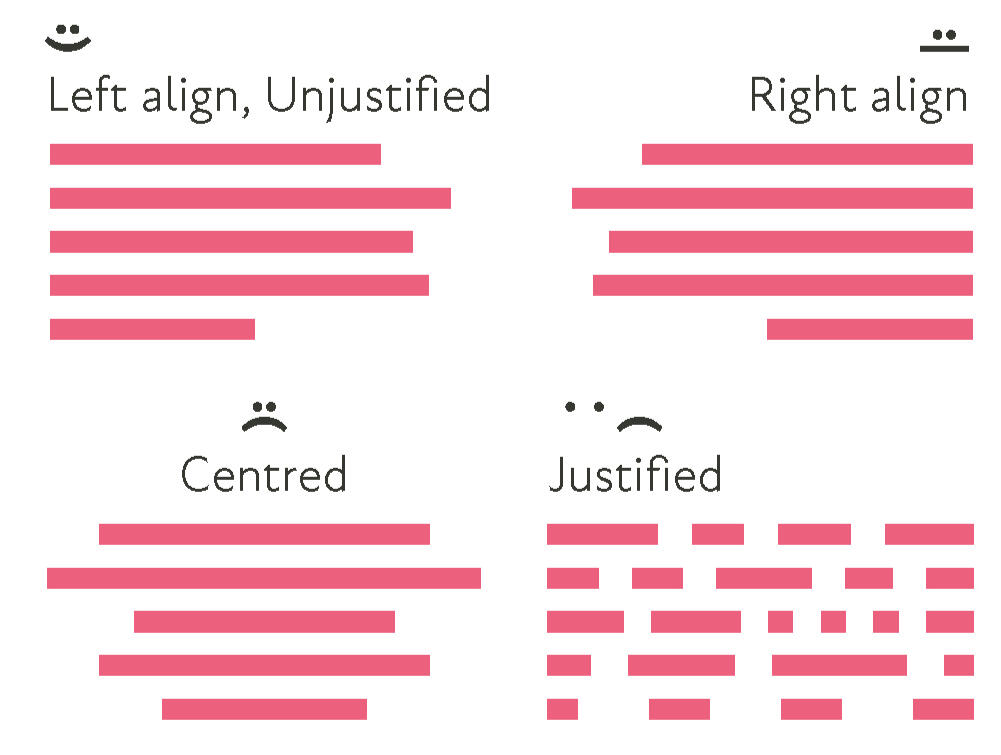
Write in Sentence Case.
Writing full words in capital letters is harder to read, so capital letters should only be used for proper nouns and words at the beginning of sentences. If you would like to highlight or emphasise words, use bold or increase the size of the font.
This is an example of sentence case.
This Is An Example Of Initial Case.
This is an example of small caps.
THIS IS AN EXAMPLE OF UPPERCASE.
Use sans serif fonts.
San serif fonts (fonts without decorative lines or curls added to them) are generally easier to read than serif fonts.
Accessible fonts do not have mirrored lettering, meaning ‘d’ is not the mirror image of ‘b’. Accessible fonts should also have distinct characters for uppercase i, lowercase L and the number 1.
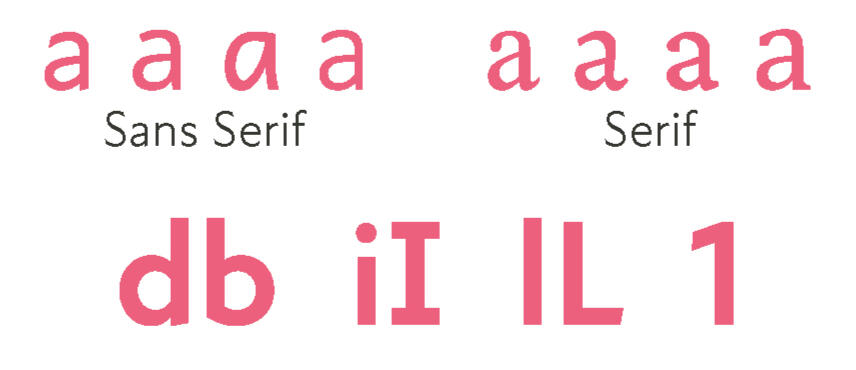
If your organisation’s brand guidelines include the use of a serif font, use a sans serif font for alternative versions of communications.
Free Sans Serif Examples
Roboto (Regular, Bold & Italic)
Atkinson Hyperlegible (Regular & Bold)
Open Sans (Regular, Bold & Italic)
All of these fonts are available for free for personal and commercial use from Google Fonts.
Use at least 12-point font size in printed media.
A point is the smallest unit of measurement in a font, and averages 0.358mm. Therefore, using 12pt should ensure text will be large enough to be comfortably read, regardless of font choice.
In digital texts, users should be able to zoom or reflow your content, so point size is less of a priority.
Use bold, avoid italics.
Italicised fonts contain exagerated shapes which can make them harder to read. Underlining text to emphasise it can be similarly disorientating. Slanted oblique fonts are often conflated with italics; while they’re less confusing, regular fonts are preferred.

Use bold sparingly
Overuse can make a piece of text harder to read, rather than highlight key information.
This is an example of text where the bold is used sparingly.
This is an example of text where the bold is used too much.
Replace italics with quotation marks.
Italics are a popular way to indicate the title of something or to signal a quote, but italicised text changes the weighting of the font and makes text harder to read.
As noted in this “Guide to Accessible Text”, quotation marks are preferable.
As noted in this Guide to Accessible Text, italicised text isn’t preferable.
Use high contrasts.
Documents with a high level of colour contrast between background and foreground colours are easier to read. You can check the strength of your colour contrast with WebAIM’s Colour Contrast Checker.

WCAG level AAA guidelines recommend a contrast ratio of at least:
7:1 for normal text (e.g. body)
4.5:1 for large text (e.g. headings)
3:1 for graphics
Contrast levels aren’t everything! Consider other forms of legibility, like combinations of glaring colours.
Use images intentionally.
Because not everyone will be able to access the image in the same way, images should not be the sole way of communicating information. Images should illustrate key messages, not introduce new points. Images and graphics should portray a diverse range of people.

Photo Credit: Julie Howden.
Language and terminology
Using inclusive language increases the number of people you can communicate with. Below, we’ve outlined some general best practices of inclusive language.
For more specific guidance on terms relating to race, sex and gender, sexuality, class and disability, please see the glossary.
Use simple sentence structures. This means that sentences are concise and ideas are broken up into short paragraphs.
Use the active voice. This means that a sentence has a subject that acts upon its verb. For example, “I attended the Make Your Mark event” (active) rather than “The Make Your Mark event was attended by me” (passive).
Address readers directly by using ‘we’ and ‘you’. This language is approachable and encourages audiences to engage with you. Inclusive communications views communication as a partnership in which all people are equal, with equal amounts to give, share and learn from each other.
Avoid jargon, such as organisational acronyms and sector-specific words like ‘heritage.’ The Heritage Blueprint Report (Young Scot and National Trust for Scotland, 2017) found that while 34% of young people were interested in ‘history’, only 16% had an interest in ‘heritage’. You may consider replacing ‘heritage’ with ‘history’, ‘culture,’ ‘buildings,’ ‘places,’ ‘collections,’ ‘stories’ and other words as appropriate.
Materials in different languages
Many potential volunteers might not have English as a first language or might not be confident in their English language skills. To encourage people from these communities to apply, you could have a few key phrases or materials translated into different languages.
Deciding what languages to offer materials in can be tricky, as demographic data often groups many ethnicities with different cultures and languages together. To help you map the languages spoken by people in your area, you could:
Check what countries or languages are represented by university societies.
Liaise with libraries, councils and council-run facilities.
Search for local Facebook groups for different nationalities and languages.
Research local restaurants or shops that offer international food.
Case Study: Supporting multilingual volunteers

For Doors Open Days 2019, the Scottish Civic Trust engaged volunteers to deliver Polish and Farsi tours of Glasgow City Chambers.
In this case study on supporting multilingual volunteers, read about how they partnered with Scottish Refugee Council, Refugee Survival Trust, Sikorski Society and Glendale Women’s Cafe to recruit refugee and migrant volunteers.
Alternative formats
In addition to offering materials in different languages, offering other alternative formats can make your volunteer programme more accessible for people with learning, hearing or visual disabilities.You could create:
Easy read versions, which break down complex information into shorter text and support the meaning of the text with the use of simple images or icons. Easy read versions are accessible to people with a learning disability and can also be accessible to those whose first language is not English or who have a lower reading level.
Large print versions, which are generally 16 to 18 point font size.
Braille versions. There are around 12,000 Braille users in the UK, and a few English Braille codes currently in use. If you choose to create Braille materials for audiences, you can post these materials for free via the Royal Mail under the Articles for the Blind scheme.
Video versions. Short videos (under 2 minutes) which can easily be shared across social media may help to reach new groups and communities. Where possible, having the video in 2-3 major languages spoken in Scotland will help to increase reach. Ensure to caption videos to increase accessibility, and double check that any auto-generated captions are accurate.
Audio versions. Community radio stations continue to be a vital source of connection for many groups. Consider short ads or features on local community radio stations.
British Sign Language (BSL) versions. 1 in 6 of the UK population experience deafness. Engaging with organisations such as Contact Scotland BSL will help to ensure your organisation is confident in supporting a broader range of volunteers.
Case Study: Engaging
with non-screen users

To address the digital divide and engage with people who experience barriers in accessing and using screen technology, the National Galleries of Scotland offers a variety of non-screen-based engagement options.
In this case study on engaging with non-screen users, read about how they use teleconferencing, postcards, letters and more.

Photo Credit: Scottish Civic Trust.
Supporting Volunteers
Once volunteers are recruited, it is essential that volunteer organisers take steps to support them and ensure that they have a positive experience. Volunteer organisers should consider:
Creating a clear induction process. This should include a volunteer agreement and an introduction to policies (see section 4).Identifying a clear point of contact and communication. This will ensure that volunteers know who they can contact with questions and concerns.Organising regular check-ins. This will provide volunteers with opportunities to discuss the experience and how it could grow and/or be improved.Hosting annual surveys, exit surveys and focus groups. This will capture honest reflections and responses from volunteers about their experiences.Providing information on skills development and employment support. This will ensure that volunteering is mutually beneficial for the organisation and volunteer, and may include developing training pathways and shadowing opportunities, offering feedback on CVs, hosting mock interviews and providing references.Signposting to other specialist organisations that can support people in various ways. Every volunteer is unique, with their own backgrounds, experiences and abilities, and facing their own set of challenges. In the current cost of living crisis, many people are struggling to make ends meet, which can negatively impact their mental health. Whilst volunteer organisers can support people within the boundaries of their role, there may be times where it is helpful and appropriate to support volunteers in accessing other specialist organisations and resources, such as financial support and debt management, health and wellbeing support, domestic abuse support, mental health support and more.Thanking volunteers and recognising their efforts. This will ensure that volunteers feel valued for their contributions. Volunteer Scotland provides guidance on recognising and valuing your volunteers.
Case study: Supporting volunteer development

The National Mining Museum, National Museums Scotland, Historic Environment Scotland and The David Livingstone Birthplace all take different approaches to volunteer development.In this case study on supporting volunteer development, learn about how they empower volunteers to make tasks their own, highlight to volunteers how they can support them and create basic development plans.
Case study: Creating pathways to volunteering for people accessing mental health support.

St Andrews Botanic Garden has recently implemented their “Planting For Your Piece” project to much success. In this case study on how to set up supported volunteer programmes for people accessing mental health support, learn about how they collaborated with local mental health organisations to recruit and support new volunteers.

Illustration Credit: Saffron Russel.
Budgeting for inclusion
Many people face economic barriers to volunteering, including travel expenses, childcare costs, food costs and a lack of free time. When applying for funding, volunteer organisers should budget for these factors to enable more people to volunteer.Especially in the current economic climate, volunteer-involving organisations should pay travel costs for volunteers as a minimum, and all other out-of-pocket expenses where they are able. Volunteer Scotland has produced further guidance on supporting volunteers during the cost of living crisis.In terms of the legalities of expenses, you must be sure you only pay the exact amount of expenses that a volunteer has incurred. You must have receipts and never pay out a fixed amount. If a volunteer is given a regular, fixed sum, they can technically be considered an employee, would need to be paid the UK minimum wage and could be taxed on that income. Paying volunteers a fixed amount can also put people receiving UK welfare benefits at risk of losing them. Volunteer Wiki has outlined additional detail about the rules around paying expenses.
Case study: Volunteering and UK welfare benefits. Experts from Volunteer Glasgow cover everything that voluntary organisations need to know about how to support people receiving UK welfare benefits to volunteer, including a few practice examples.
Below is a sample budget for costs associated with an inclusive volunteer programme.
Budget 1: Travel costs
| Item | Cost |
|---|---|
| Bus | Return or all day bus ticket, up to £6 |
| Car or van | 45p / mile. 1 |
| Motorcycle | 24p / mile. 1 |
| Bicycle | 20p / mile. 1 |
| Passengers | 5p / passenger / mile for carrying fellow volunteers in a car or van. 1 |
| Taxi | approximately £50 / return trip |
Budget 2: Childcare costs
| Item | Cost |
|---|---|
| Organise a mobile crèche | Get a quote from Flexible Childcare Services Scotland. |
| Support volunteers to access early years and childcare support | The Scottish Government offers a range of support for early years and childcare. Helping volunteers access this support could be an in-kind contribution from staff. |
| Develop family volunteering opportunities | In-kind contribution from staff |
Budget 3: Disclosure costs
| Item | Cost |
|---|---|
| Disclosures for volunteers working with children or protected adults | Volunteer Scotland provides free disclosure checks for voluntary organisations. |
Budget 4: Food costs
| Item | Cost |
|---|---|
| 5+ hours volunteering / day | Up to £5. 1 |
| 10+ hours volunteering / day | Up to £10. 1 |
Budget 5: Thanking volunteer for their time
| Item | Cost |
|---|---|
| Review volunteers’ CVs & host practice interviews | In-kind contribution from staff |
| Organise shadowing experiences | In-kind contribution from staff |
| Annual thank you event | £20 - £40 / volunteer. Volunteer organisers could organise catering and celebrate with volunteers on-site, or partner with another organisation to organise a volunteer day out. |
Budget 6: Communication costs
| Item | Cost |
|---|---|
| British Sign Language Interpreters | £100 / hour, £155 / half day, £310 / full day (Nubsli, 2024). |
| Language Interpreters | £40 - 150 / hour, £150 - £500 / half day, £250 - £700 full day (Translation & Interpreting, 2022). |
Budget 7: Other costs depending on role or sector
| Item | Cost |
|---|---|
| Training required by volunteers | Varies. |
| Equipment or clothing costs required by volunteers | Varies. |
1 As per rates from HMRC.
2 At the time of writing (January 2025), changes are being made to the current disclosure system and funding. Please check Volunteer Scotland Disclosure Services for the most up to date information.

Photo Credit: David Livingstone Birthplace.
Inclusion checklist
Please use this checklist to understand the barriers to inclusion in your organisation. This can be used to develop an inclusive volunteering plan (see Section 8). Which of the below practices and facilities can your organisation offer to volunteers?
1. Economic
Travel expenses can be paid up-front.
Travel expenses can be reimbursed.
Childcare can be provided.
Equipment costs are covered.
Disclosure is required, but the cost is covered and previous convictions do not necessarily disqualify applicants.
Volunteer expenses will not compromise UK state benefits.
Volunteers are thanked for their time via social events.
Volunteers can be reimbursed for up to £5 of food costs per 5 hours of volunteering.
2. Social & Cultural
Venue staff have undergone equality, diversity and inclusion training.
Volunteers of all skill sets and backgrounds are encouraged to apply to share their unique expertise, and previous experience or a degree is not required.
Volunteer taster sessions are available.
Opportunities to shadow an
existing volunteer to learn about the role are available.
There are multiple ways to apply: application form, phone call, voice note, video, etc.
Volunteer managers are happy to chat with volunteers about their needs and adapt roles to suit them.
Volunteer recruitment materials represent a diverse range of people.
Volunteer recruitment materials are available in a range of languages.
The organisation has an equality, diversity and inclusion strategy and is committed to welcoming people of all backgrounds, experiences, identities, abilities and needs.
3a. Physical: Entering and Accessing Venues and Sites
Nearby accessible public transport.
Disabled parking on-site.
Free parking nearby.
Bike rack on-site.
Wheelchair accessible ramps,
toilets and lifts.
Seating available throughout
Access rider can be included with submission.
3b. Physical: Engaging at Venues and Sites
Hearing loop.
Gender neutral toilets.
Gender neutral baby changing facilities.
Provides free period products.
Available quiet spaces.
Drinking water refill stations.
Service dogs fitted with a suitable harness or on a lead are allowed in the venue.
Water available for service dogs.
The site offers interpretation in languages besides English.
BSL interpretation can be provided
A visual and sensory guide is available with information about what to expect at the venue.
Large print and Braille options available.
Magnifying glasses are available for use.
Volunteers can specify if they’d like to come in at quieter times.
If you want more detailed feedback on the accessibility of your volunteer programme, you can partner with a local organisation that engages with marginalised people to arrange an accessibility audit with their members. This may consist of their members visiting your venue, reviewing policies or role descriptions and/or participating in a volunteer taster session and giving you feedback on how to be more accessible or inclusive. Consider contacting potential partner organisations for quotes and developing a budget for this type of expert work.

7. Benchmarking and Tracking the Benefits of Inclusive Volunteering
Inclusive volunteering has benefits for individuals, organisations and societies. This section of the toolkit outlines the social justice and economic case for inclusive volunteering, and why collecting data on your volunteer programme is a critical tool for change.
Why inclusion is a social justice and economic issue
The Centre of Economics and Business Research’s recent research into the value of volunteering (2023) showed that volunteering makes a major contribution to the economy and can be considered a vital part of Scotland’s Inclusive Growth Strategy:
“The Scottish Government defines inclusive growth as ‘growth that combines increased prosperity with greater equity; that creates opportunities for all; and distributes the dividends of increased prosperity fairly" (Scottish Government, 2015).”
What does it mean to fairly distribute the dividends of volunteering opportunities in Scotland? The cost of living crisis has had an impact on volunteering through cuts to funding and giving, and constrained time or personal circumstances for individual volunteers.
Combined with an increase in the need for volunteers, this produces a complex challenge for the sector:
How can we ensure the benefits of being a volunteer are equally distributed in society when it relies on a high volume of unpaid labour?
How do we support individuals, groups, and communities who have additional barriers to participating in volunteering?
What can volunteering offer individuals and society?
By volunteering, people can:
Meet people and develop new social networks.
Develop skills and experience.
Build their CV.
Gain knowledge.
Increase confidence and self-esteem.
Improve wellbeing.
Become more involved in their community and built a greater sense of belonging.
Involving a wider range of volunteers enables volunteer organisations to:
Value and celebrate the skills and experiences of Scotland’s diverse society.
Adhere to funding requirements for inclusion and diversity.
Reflect the diversity of Scotland’s communities.
Expand engagement with volunteering.
Develop volunteer organisers’ skills around inclusive engagement.
Although volunteering has many documented benefits, it has not previously been accessible to, and inclusive of, everyone, thereby limiting its positive impact. Involving a more diverse range of people in volunteering would:
Enable everyone to have the opportunity to experience the social, physical and health benefits of volunteering, thereby reducing exclusion.
Ensure that activities undertaken by voluntary organisations meet the needs of Scotland’s diverse communities.
Inclusive volunteering at your organisation

How does your organisation recruit, retain, and value volunteers? Consider each in turn.
Is there anything about diversity and inclusion that is a barrier for your organisation (either skills, knowledge about terminology or experience of practice)?
Is diversity and inclusion important to your volunteering organisation? If so, how does this work in practice?
Are there any communities you feel are ‘missing’ from your volunteering organisation? Why do you think that is?
Where would you place your organisation in its journey to be more diverse and inclusive:
1. Early work?
2. Some initiatives are underway?
3. Well developed?
Are there other organisations who you think you could learn from or share your best practice with?

Illustration Credit: Saffron Russell
Data and benchmarking: why does it matter?
Collecting data from volunteers about their backgrounds is a powerful tool that can enable you to create effective inclusive volunteering plans.
Data can help identify trends and evidence, as well as contradict or confirm anecdotal knowledge you have about your organisation. Organisations should never assume anything about someone’s identity - collecting personal data from volunteers themselves ensures that you have an accurate picture of your volunteer programme.Basic data gathering on protected characteristics can help an organisation to benchmark where they are, and how they compare against other organisations. The same data can be used to identify goals for the future (e.g. creating a plan to engage more disabled volunteers and support their ongoing participation). This section outlines a range of data that can be tracked about volunteers, along with how that data can be sensitively stored and used.While there is some data on volunteering demographics in Scotland (see section 2), there are gaps in the data picture.If all organisations gathered more basic data about volunteering, we could:
Inform a more detailed national picture about who volunteers and why.
Evidence barriers to volunteering for marginalised and underrepresented groups.
Demonstrate how the social, cultural, and economic benefits of volunteering can be distributed across Scottish society.
Combining qualitative (non-numeric information about emotions and perceptions) and quantitative (numeric information such as statistics) data can help to gather a range of evidence. Each type of data serves a key and different purpose, and are most effective when used together.Quantitative data is useful for creating concrete goals (e.g. we want to increase the number of disabled volunteers by 30% in three years).Qualitative data can be particularly useful when you’re trying to understand the reason for more complex barriers (e.g. why people don’t feel included). Qualitative data is often best collected through surveys or focus groups (see section 6). Quantitative data is useful for creating concrete goals (e.g. we want to increase the number of disabled volunteers by 30% in three years).The types of questions you ask should be shaped by your organisation’s objectives as well as funders’ requirements. For example, you may want to include questions like:
1. What are your reasons for volunteering with us?
Meet new people
Develop skills and experience
Build my CV
Gain knowledge
Interest in the topic / sector
Increase confidence and self-esteem
Give back to the community
Make a difference
Improve my wellbeing
(Write in)
2. How does volunteering with us make you feel?
3. What do you like about volunteering with us?
4. What could we do to improve your volunteering experience?
5. How else could we support you to get the most out of your volunteer experience? Are there things we could do to make it more accessible or easier for you to enjoy?
6. How satisfied are you with your volunteering experience?
Not very satisfied
Not satisfied
Neutral
Satisfied
Very satisfied
7. My volunteering experience has (check all that apply):
Helped me with developing skills
Increased my confidence
Improved my health or wellbeing
Made me want to look at training or work opportunities in the sector
(Write in)
8. How else has volunteering impacted you (if applicable)?
9. Is there anything else you want to say about your volunteer experience?
Vision for Volunteering has created a free resource pack to support organisations to use ripple impact mapping, a participatory and interactive data capture method, to better understand the ‘ripples’ of impact that are hard to measure by traditional methods or that don’t happen immediately.
Equalities monitoring
Equalities monitoring involves the collection of information, or data, about volunteers. Many organisations choose to monitor ‘protected characteristics’ as identified in The Equality Act (2010):
Age
Disability
Gender reassignment
Marriage and civil partnership
Pregnancy and maternity
Race
Religion or belief
Sex
Sexual orientation
A template Equalities Monitoring form is available from Scottish Council for Voluntary Organisations (see appendix).
Collecting data about socio-economic backgrounds and social mobility
Although work on inclusion often focuses on protected characteristics, socio-economic background is a key underpinning condition for exclusion, discrimination and inequality.
For an insight into tackling socio-economic inequalities, please see the Social Mobility Commission’s Socio-economic Diversity and Inclusion toolkit, which is based on case studies from the creative industries.
Data storage, ethics and accountability
When collecting, storing and analysing personal data about volunteers, it is important to comply with legal requirements to protect people’s privacy.
Not everyone will feel comfortable providing data about themselves. It’s important to explain the reasons why you are asking for the data, how you will keep it safe and how you will use it. Here is a template statement to use when collecting equalities data:
Equality and inclusion are at the heart of our work. We collect information about volunteers’ backgrounds and identities to help us ensure that our volunteer programme reflects the diversity of Scotland’s people.Supplying personal data to us is voluntary. The information you supply is confidential and anonymous. It will not be linked to your application and is used for monitoring and reporting purposes only.
It is important to comply with the Data Protection Act (2018) when processing personal data about individuals. Under this law, you must ensure:
The data is used for a clear, specific purpose.
You collect and use the minimum amount of data required to fulfil your purpose.
The data is kept for no longer than is necessary.
You provide clear instructions and a point of contact for people to get in touch if they want you to remove their data from your records.
The data is stored securely.
SCVO provides detailed guidance on data protection, and the Information Commissioner’s Office has a data protection self-assessment toolkit. If you are a large organisation and will be collecting a high volume of data, Volunteer Scotland provides guidance about responsible research and ethics.
Volunteer equalities monitoring

What data do you collect and are you confident you are complying with data storage requirements?
How do you use data in organisational decision making and why? Does social inclusion feature as a category to analyse?

Illustration Credit: Saffron Russel.
Quality standards
Working within your organisation to achieve a recognised quality standard provides a framework that can help you evaluate and improve your volunteer programme.[Volunteer Scotland’s Volunteer Charter]((https://www.volunteerscotland.net/volunteer-practice/quality-standards/volunteer-charter/) is an initial standard for volunteer-involving organisations to sign up to. It sets out ten principles which help to underpin good relations within a volunteering environment. It is open to any group or organisation from any sector that involves volunteers.Once your organisation signs up to the Volunteer Charter, you may consider working towards a further quality standard:
Volunteer Friendly Award is a Scotland quality standard for small to medium volunteer programmes, including small community and mutual aid groups. Requirements are set at an achievable level for each volunteer programme, covering five foundation quality standards and 18 key volunteer practices.
Investing in Volunteers (IiV) is a UK quality standard for medium to large volunteer programmes. It aims to improve the quality of the volunteering experience and ensure organisations acknowledge the contribution of volunteers. The IiV process includes an evaluation of your volunteer programme, with tailored support for how to develop a more inclusive approach.
By achieving a quality standard, you’ll be part of a growing community of peers focused on quality volunteer practice.

8. Developing an Inclusive Volunteering Plan
An Inclusive Volunteering Plan should set out an evidence-based, current picture of involvement across an organisation of marginalised people; highlight priority areas for development in inclusion; and set out plans and objectives for changes. This section of the toolkit supports you to develop your own Inclusive Volunteering Plan.
Process
1. Assess: Based on the toolkit, what are your organisation’s priority areas for development in inclusion (e.g. recruitment)? Identify 2-3 priority areas.
2. Plan and consult: What are your plans for positive changes? How did you develop these plans? Have you consulted with volunteers and relevant stakeholders? How will you measure or track positive change? Will this be through qualitative or quantitative data?
3. Pilot interventions: Test your plans in a limited-limited exercise (e.g. 3 months).
4. Evaluate: Did the interventions work? How has this been evidenced?
5. Reflect: Capture the learning from the exercise (including what didn’t work) and revisit your priority areas. Has there been positive change for inclusion?
Case study: Creating an inclusive volunteer philosophy. Creating a volunteer philosophy can help you define why your organisation involves volunteers and how you involve volunteers in carrying out your mission. In this case study on creating an inclusive volunteer philosophy, HMS Unicorn explains why and how they created their “WaveMakers” volunteering programme on a limited budget to make a real, life-changing difference to a diverse range of local residents.
Planning for inclusive volunteering

How inclusive do you think your organisation is? On a scale of 1-10, how confident are you that the organisation has an inclusive approach to volunteering -
(1 least confident, 10 most confident)?
Do you have the policies and structures in place to support people? Do you have any policies centred on developing an inclusive approach? If so, do they have an inclusive volunteering plan? Based on this toolkit, will you make any changes?
What can your organisation change in the short and medium term to improve inclusion? If you do not have policies centred on developing an inclusive approach to volunteering, design an inclusive volunteering plan based on:
3 things you can change or implement now, and 3 things you would like to change or implement in the medium term.
How can your organisation measure and benchmark inclusion more effectively? What kind of data do you need and how will you collect, store, and analyse it for evidence-based decision making?

Reflective Worksheet
To help you start organising your thoughts, we’ve collaborated with Volunteer Scotland’s Volunteering Action Plan to create a reflection worksheet.You can download a form fillable worksheet, or copy the questions below and fill them out using whatever word processor or mind-mapping app that suits your process:
Barriers to volunteering with my organisation
What factors, practices or policies may be preventing people from volunteering with us?
External Barriers
Internal Barriers
Who is affected?
Actions to take to remove barriers
What changes can we make to enable more people to volunteer? What resources, funding or new relationships would I need to achieve this?
Short Term
Medium Term
Long Term
Potential collaborators
Which allies, partners or networks could I draw on or work with?
Resources to investigate
What helpful guides, templates and toolkits are available to support me in making changes? For example:
How changes and success will be measured
For example: equalities data, surveys on volunteer experience, KPIs to hit, etc.

Glossary
Diversity
Diversity is the acknowledgement of and respect for differences within and between groups of people.(Group for Education in Museums, 2018).
Accessibility
Accessibility is ensuring that people are not excluded from using something on the basis of experiencing a disability. Accessibility means that people can do what they need to do in a similar amount of time and effort as someone that does not have a disability. It means that people are empowered, can be independent and will not be frustrated by something that is poorly designed or implemented.(UK Government, 2016).
Inclusion
Inclusion is the active process of working to break down the barriers that exclude people from accessing your services(Group for Education in Museums, 2018).
Exclusion
Exclusion means being shut out from any of the political, social, cultural or economic systems which determine the social integration of a person in society. People who are excluded from society and the privileges of being part of its systems are often referred to as ‘marginalised’ or ‘oppressed’ people.(Group for Education in Museums, 2018).
Equality
Equality is an approach that ensures that every individual has an equal opportunity to make the most of their lives and talents. In other words, equality means ensuring that everyone has the same opportunities and receives the same support.(Social Change UK, 2023).
Equity
Equity is about giving people what they need in order to make things fair. In other words, equity means giving more or different support to those who need it. The difference between equality and equity must be emphasised. Although both promote fairness, equality achieves this through treating everyone the same regardless of need, while equity achieves this through treating people differently depending on need.(Social Change UK, 2023).
Sex and Gender
Sex at birth
Infants are assigned a sex at birth, ‘male’ or ‘female’, based on the appearance of their external anatomy. However, the development of the human body is a complex process, and sex is not solely determined by anatomy, nor is it strictly binary. As many as 1.7% of people are born with an intersex trait.(GLAAD, 2022).
Intersex
Intersex refers to someone with one or more innate sex characteristics, including genitals, internal reproductive organs, and chromosomes, that fall outside of traditional conceptions of male or female bodies.(GLAAD, 2022).
Gender Identity
A person’s knowledge of their own gender. Everyone has a gender identity. For most people their gender identity matches the sex they were assigned at birth. For trans people, their gender identity does not align with the sex they were assigned at birth. Many people have a gender identity of man or woman (or, for children, boy or girl).
For other people, their gender identity does not fit neatly into one of those two binary genders. Gender identity is not visible to others.
You cannot look at someone and “see” their gender identity.(GLAAD, 2022).
Gender Expression
External manifestations of gender, expressed through a person’s name, pronouns, clothing, haircut, voice, and/or behaviour. Societies classify these external cues as masculine and feminine, although what is considered masculine or feminine changes over time and varies by culture.(GLAAD, 2022).
Trans
An adjective to describe people whose gender identity differs from the sex they were assigned at birth. People who are transgender may also use other terms, in addition to transgender, to describe their gender more specifically. Use the term(s) the person uses to describe their gender. It is important to note that being transgender is not dependent upon physical appearance or medical procedures.
A person can call themself transgender the moment they realise that their gender identity is different than the sex they were assigned at birth.(GLAAD, 2022).
Cis
An adjective used to describe people who are not transgender. A cisgender person is a person whose gender identity is aligned with the sex they were assigned at birth.(GLAAD, 2022).
Nonbinary and/or Genderqueer
Nonbinary is an adjective used by people who experience their gender identity and/or gender expression as falling outside the binary gender categories of man and woman. Many nonbinary people also call themselves transgender and consider themselves part of the transgender community. Others do not.
Nonbinary is an umbrella term that encompasses many different ways to understand one’s gender. Some nonbinary people may also use words like agender, bigender, demigender, pangender, etc. to describe the specific way in which they are nonbinary. Always ask people what words they use to describe themselves.
Nonbinary is sometimes shortened to enby.(GLAAD, 2022).
Sexuality
LGBTQ
Acronym for lesbian, gay, bisexual, transgender and queer. LGBT and LGBTQ+ are also used, with the + added in recognition of all non-straight, non-cisgender identities.(GLAAD, 2022).
Gay
An adjective used to describe a person whose enduring physical, romantic and/or emotional attractions are to people of the same sex (e.g. gay man, gay people). Sometimes lesbian is the preferred term for women.(GLAAD, 2022).
Lesbian
A woman whose enduring physical, romantic and/or emotional attraction is to other women. Some lesbians may prefer to identify as gay or as gay women.(GLAAD, 2022).
Bisexual
An adjective used to describe a person who has the potential to be physically, romantically, and/or emotionally attracted to people of more than one gender, not necessarily at the same time, in the same way, or to the same degree. The bi in bisexual refers to genders the same as and different from one’s own gender.(GLAAD, 2022).
Queer
An adjective used by some people, particularly younger people, whose sexual orientation is not exclusively heterosexual (e.g. queer person, queer woman).
Typically, for those who identify as queer, the terms lesbian, gay, and bisexual may be perceived to be too limiting and/or fraught. Once considered a pejorative term, queer has been reclaimed by some LGBTQ people to describe themselves. However, it is not a universally accepted term even within the LGBTQ community, so use caution when using it outside of describing the way someone self-identifies or in a direct quote.(GLAAD, 2022).
Class
Class is a series of intersecting factors determining perceived social and economic status.(Savage et al, 2013)
Working Class
People from low socioeconomic backgrounds.
Low socioeconomic backgrounds mean people who have a low amount of economic (how much money you have), social (who you know) and cultural (what you know) privilege.(Bourdieu, 1983)
Deprived Areas
The Scottish Index of Multiple Deprivation (SIMD) is a relative measure of deprivation across 6,976 small areas (called data zones). If an area is identified as ‘deprived’, this can relate to people having a low income but it can also mean fewer resources or opportunities. SIMD looks at the extent to which an area is deprived across seven domains: income, employment, education, health, access to services, crime and housing.(Scottish Government, 2020)
Race
Race is a social construct (i.e. human-made invention) based on skin colour and facial features (shape of eyes, nose, lips, hair texture, etc.). Even if it isn’t biologically ‘real,’ its impact on people is very much a reality. Race is a system of social categorisation which advantages certain groups of people and disadvantages other groups of people.(The Anti-Racist Educator, 2019).
Prejudice
Prejudice is often understood as an unfavourable or unreasonable opinion, feeling or attitude especially of a hostile nature, regarding an ethnic, racial, social or religious group.(The Anti-Racist Educator, 2019).
Racism
Racism is different from racial prejudice, hatred, or discrimination. Racism involves one group having the power to carry out systematic discrimination through the institutional policies and practices of the society and by shaping the cultural beliefs and values that support those racist policies and practices.However, racism is often simplified to discrimination against a person or group of people based on their race.(Dismantling Racism Works, 2021).
Xenophobia
Xenophobia is prejudice against people who are viewed as being ‘foreign’ or ‘from another country’. This often gets confused with racism: racism has more to do with skin colour and facial features while xenophobia has more to do with nationality, language/accent, culture and ethnicity.(The Anti-Racist Educator, 2019).
BME / BAME
BME stands for Black and Minority Ethnic and it includes people who might face discrimination on the basis of ethnicity, language, religion, tradition and cultural practices.
BAME stands for Black, Asian and Minority Ethnic. The addition of the ‘A’ makes sense in the UK considering that people of Asian descent make up a big chunk of the total minority ethnic population. These terms tend to be used in British research and policy on race and diversity. While this term is politically correct and officially recognised, it is imperfect. The word ‘minority’ can be frustrating due to its connotations of weakness and powerlessness.
In fact, some groups that constitute a ‘minority’ in certain regions and countries actually constitute a majority in other regions or around the world as a whole – on a global scale, people racialised as white are actually the minority population but they are granted the ‘majority’ status in Scotland.(The Anti-Racist Educator, 2019).
Person of Colour
The umbrella term ‘person of colour’ (POC) was first used in the USA, but it is increasingly used by activists in the UK. It essentially refers to anybody who is not white. Many believe it is more empowering than the term ‘non-white’ and ‘minority’ (in BME and BAME) because it does not revolve around whiteness.
This term must not be confused with coloured – an outdated word that many will find offensive today due to its historical use as a pejorative.(The Anti-Racist Educator, 2019).
Disability
Disability is used as an umbrella term – this is broadly accepted but some groups and individuals do not necessarily identify with the term and would not consider themselves to be disabled. The term disability covers a wide range of different conditions and impairments. There is a broad legal definition for disability in the UK in the Equality Act 2010: “A physical or mental impairment that has a ‘substantial’ and ‘long-term’ negative effect on your ability to do normal daily activities”.(The English Federation of Disability Sport, 2018)
Social Model of Disability
The social model of disability says disability is caused by barriers that arise because society is not designed to accommodate people who have impairments. It is these barriers that disable people who have impairments, and stop them from being included in society and participating on an equal basis.
If these barriers are removed, a person may still have an impairment but would not experience disability. The social model of disability was developed by disabled people and it is supported by organisations led by disabled people. This is in comparison to the medical model of disability, which says that a person’s health condition or impairment causes the disability and that this requires medical intervention and treatment to cure the problem.(Inclusion Scotland, 2023)
Barriers
The things that prevent disabled people from participating in everyday life. They include everything from inaccessible buildings, websites and people’s attitudes or assumptions.(The English Federation of Disability Sport, 2018)
Person-centred Descriptions
Communications should only mention characteristics like a person’s disability when relevant. When it is relevant to mention a person’s or group’s disability, the emphasis should be put on their humanity, rather than their characteristics.(The English Federation of Disability Sport, 2018)

Appendix
Sample Equalities
Monitoring Form
This template has been provided the Scottish Council for Voluntary Organisations (SCVO).
Use of this model policy is entirely at your own risk. This policy should be adapted to suit your own organisational needs, and you should ensure it meets your own specific requirements. You should also check this policy is compliant with the law and your organisation’s governing document.
No liability rests with SCVO.
For more information see our information on using SCVO templates.
This is a sample form that you can adapt or develop to meet your needs. Make sure you adapt this template to comply with the UK General Data Protection Regulation (UK GDPR). If you need help with this, go to www.ico.org.uk.
Start of form.
[INSERT ORGANISATION NAME] wants to meet the aims and commitments set out in its equality policy. This includes not discriminating under the Equality Act 2010 and building an accurate picture of the make-up of the workforce in encouraging equality and diversity.
The organisation needs your help and co-operation to enable it to do this but filling in this form is voluntary.
1. How would you describe your gender?
Man
Woman
Intersex
Non-binary
Prefer not to say
If you prefer to use your own term, please specify here:
2. Do you identify as transgender?
Yes
No
Prefer not to say
3. Are you married or in a civil partnership?
Yes
No
Prefer not to say
4. What is your age?
16 to 24
25 to 29
30 to 34
35 to 39
40 to 44
40 to 49
50 to 54
55 to 59
60 to 64
65 to 74
75 to 84
85+
Prefer not to say
5. What is your ethnicity?
Prefer not to say
White
English
Welsh
Scottish
Northern Irish
Irish
British
Gypsy or Irish Traveller
Roma
Prefer not to say
Any other White background, please write in:
Mixed/multiple ethnic groups
White and Black Caribbean
White and Black African
White and Asian
Prefer not to say
Any other mixed background, please write in:
Asian/Asian British
Indian
Pakistani
Bangladeshi
Chinese
Prefer not to say
Any other mixed background, please write in:
Black/African/Caribbean/Black British
African
Caribbean
Black British
Any other Black/African/Caribbean background, please write in:
Other ethnic group
Arab
Any other ethnic background, please write in:
6. Do you consider yourself to have a disability or health condition?
Yes
No
Prefer not to say
What is the effect or impact of your disability or health condition on your ability to give your best at work?Please write it in here:
The information in this form is for monitoring purposes only. If you believe you need a “reasonable adjustment”, then please discuss this with your manager, or the manager running the recruitment process if you are a job applicant.
7. What is your sexual orientation?
Heterosexual
Gay
Lesbian
Bisexual
Prefer not to say
Specify own term, please write in:
8. What is your religion or belief?
No religion or belief
Buddhist
Christian
Hindu
Jewish
Muslim
Sikh
Prefer not to say
9. What is your current working pattern?
Full-time
Part-time
Prefer not to say
If other, please write in:
10. What is your flexible working arrangement?
Carer
Unemployed / never worked
Routine manual and service occupation (e.g. van driver, cleaner, porter, waiter/waitress, bar staff)
Semi-routine manual and service occupation (e.g. postal worker, security guard, machine worker, receptionist, sales assistant)
Technical and craft occupation (e.g. fitter, plumber, printer, electrician)
Clerical and intermediate occupation (e.g. secretary, nursery, nurse, office clerk, call centre agent)
Middle or junior manager (e.g. office manager, warehouse manager, restaurant manager)
Modern professional occupation (e.g. teacher, nurse, social worker, artist, musician, software designer)
Traditional professional occupation (e.g. accountant, solicitor, scientist, medical practitioner)
Senior managers or administrator (e.g. finance manager, chief executive)
11. What is your flexible working arrangement?
None
Flexitime
Staggered hours
Term-time hours
Annualised hours
Job-share
Flexible shifts
Compressed hours
Homeworking
Prefer not to say
If other, please write in:
12. Do you have caring responsibilities?
None
Primary carer of a child/children (under 18)
Primary carer of disabled child/children
Primary carer of disabled child/children (18 and over)
Primary carer of older person
Secondary carer (another person carries out the main caring role)
End of form.
Contents:
Project Report
All links lead to content on this website.
1. Summary
2. Key Findings
3. Analysis.
1. Summary
Introduction
Volunteering 1 is often seen as a social and individual good, contributing to personal and collective health and well-being, where people and communities are invested in, recognised and supported. However, for this potential to be fulfilled, the voluntary sector has to think about the inequalities faced by society as a whole, discarding a view of volunteering as solely initiated or driven by choice or openness. The voluntary sector has an important role in challenging and transforming inequalities, where the commitment to making a difference is often part of organisational missions and stated intentions.People volunteer all of the time. They may help out a neighbour. It might be part of religious observation or service. It can form part of the norm of a community. But what gets called ‘volunteering’ is often a recognised and structured opportunity that can accrue social privilege or help to scaffold access to economic privilege.How can we ensure that volunteering as a sector represents and serves the breadth and depth of our society’s needs? How do we ensure it doesn’t revert to older forms of philanthropy which created a hierarchy between people with the skills and resources to help the world around them, and people, places, and organisations, which need help?Volunteering organisations may be able to act as transformative sites of participation, able to respond to questions of varied resourcing, recognition and support. At present, this report reveals a patch-work provision of inclusive volunteering experiences, resources, supports and practices in Scotland. While this is a consequence of the informality around much volunteering (and is an important benefit in terms of flexibility), it can unintentionally foster the very same inequalities that volunteer organisations work so hard to overcome in their social mission.
Footnote
1. Scottish Government (2019) defines volunteering as: “Volunteering is a choice. A choice to give time or energy, a choice undertaken of one’s own free will and a choice not motivated for financial gain or for a wage or salary. ‘Volunteering’ describes the wide range of ways in which people help out, get involved, volunteer and participate in their communities (both communities of interest and communities of place).” Volunteering can be both formal (undertaken through a voluntary organisation) and informal (helping out others in a self-managed way). While often focusing on formal volunteering roles within organisations, this report also queries a neat division between informal and formal roles, with the latter accruing more recognition, whilst the former being often necessarily practised in more disadvantaged communities and without the benefit of social recognition or economic reimbursement.
About this project
With the support of the Scottish Government, and as part of Scotland’s Volunteering Action Plan, a project was developed by Make Your Mark and the University of Strathclyde to support inclusive volunteering programmes across Scotland’s voluntary sector.The project had two elements:
Gathering evidence on barriers to cultures of inclusive volunteering in volunteer organisations and community-led groups with lived experience of marginalisation 2 (delivered through focus groups and a survey).
Designing an Inclusive Volunteering Toolkit.
The project commenced in October 2022 with the first development programme workshop, and came to a close in July 2023 with the launch of the Inclusive Volunteering Toolkit. This report offers a summary of key findings and recommendations from the project.
Footnote
2. ‘Marginalisation’ describes the process by which some people are ‘systematically excluded from meaningful participation in economic, social, political, cultural and other forms of human activity in their communities and thus denied the opportunity to fulfil themselves as human beings’ (Ng et al, 2014). The term highlights the inequality that underpins the creation of identities and hierarchised power structures. As people have multiple identities (sex, gender, sexuality, race, ethnicity, nationality, immigration status, socio-economic class, etc), each person has a combination of multiple marginalised and non-marginalised identities. The idea of marginalisation as having multiple and sometimes compounding structural dimensions has been termed and popularised as ‘intersectionality’ (Crenshaw, 1989)
Why inclusive volunteering matters
Volunteering has significant economic and social impacts in Scotland. Volunteering supports skills development, improves individual physical and mental health and wellbeing and strengthens social bonds within and between communities (Scottish Government, 2019). Although volunteering has many benefits, it has not historically been accessible or inclusive for everyone.There have been various initiatives aiming to address inclusive volunteer programmes. In 2004, the Scottish Executive published its Volunteering Strategy to improve volunteer experiences, remove barriers to participation and support young people through targeted interventions such as Project Scotland. In 2013, the UK-wide #iwill campaign sought to increase by 50% the proportion of young people taking part in meaningful social action by 2020. In 2017/18, the Scottish Government indicated its intention to reinvigorate volunteering by focusing on young volunteering opportunities during the Year of Young People and supporting groups experiencing barriers to volunteering. In 2019, The Scottish Government published Volunteering For All, which provided a comprehensive framework for articulating a national narrative for the value of volunteering, alongside a strategic approach to incorporating volunteering into broader programmes of inclusive social and economic growth.Major reports such as Time Well Spent (NCVO, 2022) and resources such as Equity, Diversity and Inclusion in Volunteering (Kanemura et al, 2021), have been vital for capturing the complexity of intersectional inequalities, the long-term impact of the pandemic, and the ongoing cost of living crisis on the volunteer sector. As the voluntary sector becomes more important for maintaining services and care in society, how can we ensure that the benefits of volunteering are equally shared, and that the full breadth and depth of our society’s experience is represented in the volunteering sector?To date, many of the initiatives to remove barriers to volunteering have focussed on youth engagement. From 2009–2016, the percentage of young people aged 11–18 in Scotland who volunteered at least once per year significantly increased from 33% to 52% and remained steady at approximately 50% through 2019 (Volunteer Scotland, 2020). Youth volunteering has decreased by 12% between 2019 and 2022, predominantly due to the impacts of COVID-19 and the cost of living crisis, but still remains 10% higher than average adult (over 18) volunteering engagement (Volunteer Scotland, 2022).Whilst initiatives have been successful in increasing youth volunteering, disparities in engagement have persisted across other demographics.From 2007 – 2017, the Scottish Household survey indicated that volunteer engagement rates were consistently lowest amongst people:
without a degree or professional qualification
from lower income groups
from more deprived areas
from minority ethnic groups
The most recent Scottish Household Survey (2021) similarly found that those most likely to volunteer are:
people with a degree or professional qualification
from higher income groups
from less deprived areas
white and non-disabled
The disparities in volunteering have profound implications for wider society, where the accrual of benefits for more privileged people increases inequality.
2. Key Findings
Although ‘inclusion’ has been a priority of national volunteering agendas in Scotland for almost two decades, systemic inequalities, a lack of staffing and funding dedicated to volunteering, a lack of volunteer equalities data and entrenched organisational cultures continue to make formal volunteering inaccessible for many people, especially those from marginalised groups. However, it is again important to note that marginalised people have historically and currently volunteer informally at high rates, a practice necessitated by long-term exclusion from access to economic, social, political and cultural privilege.Despite significant barriers to societal and organisational change, the progress made in increasing youth engagement shows that with sustained commitment across the voluntary sector, coupled with adequate staffing and funding, change can be made. This research builds on existing inclusion initiatives, many of which focused on youth volunteering, and uses an intersectional model to analyse multiple dimensions of marginalisation and suggest key recommendations for inclusive volunteering programmes.
Barriers to volunteering
Our research has identified a few key barriers to inclusive volunteer engagement, including:
General under-confidence in EDI-focused policy, legislation and practice.
Many volunteer organisers expressed a nervousness or lack of confidence in relation to equality, diversity and inclusion, especially in relation to what their organisations were legally required to do to support a diverse range of people to volunteer. Many also noted uncertainty around what terms to use when speaking about various identities and backgrounds, and expressed a fear of ‘getting it wrong’.
A lack of organisation-specific strategies and targets for inclusion.
Whilst many volunteer organisers expressed their intentions to foster a welcoming environment for everyone, there was a lack of concrete commitments, plans and targets for inclusion work within organisations. Instead, volunteer organisers were more reactive to specific volunteer requirements. This is likely a function of volunteer engagement staffing and funding limitations noted by many respondents.A lack of proactive and specific inclusion strategies can lead to marginalised people being engaged as a ‘tick box’ exercise wherein they are expected to fit into structures that don’t suit their needs and desires for volunteering. This can create volunteering relationships that are not mutually beneficial and exploitative in that marginalised people fulfil organisational EDI quotas, but do not have positive volunteering experiences.If organisations do not take a proactive approach to inclusion, the onus is put on volunteers to highlight their needs and ask for adjustments, which can make them feel like ‘the problem’.
Lack of collection of and standardisation in data collection around volunteer demographics.
Collecting equalities data on volunteers is not legally mandated, and so many organisations do not collect such data, or collect some equalities data (e.g. on age), but not other equalities data (e.g. on race, sexuality, class).The lack of collection of equalities data, and the varying types of equalities data collected, makes it difficult to get an accurate understanding of who, and who does not, volunteer. Our research initially sought to collect volunteer equalities data in Scotland’s heritage sector and produce a benchmark for future inclusion work. However, as less than a third of respondents collected equalities data, there was not enough data to produce an accurate representation of volunteers.Organisations that do collect equalities data have expressed an unwillingness or anxiety around sharing their equalities data for sectoral and national benchmarking efforts. This could be for several reasons:
People are not clear on why equalities data is collected, and how it can be used to improve inclusion within their volunteer programmes
People are not confident with GDPR and regulations around data collection, and may be nervous about the legalities of collecting, processing and sharing personal data.
People may think that their organisations are not diverse, and may be nervous about measuring or reporting this to boards and funders.
People are committed to the idea that ‘everyone is welcome’ in their organisation, thereby discouraging action on a problem that they may not think exists.
People are nervous that expanding and diversifying volunteering may threaten paid jobs.
Recent events (COVID-19 and the cost of living crisis) disproportionately affecting marginalised people.
Broader societal inequalities shape how and if people can engage with volunteering. Marginalised people are more likely to have greater time and economic pressures that make it more difficult for them to volunteer, and the resulting lack of diversity in many voluntary organisations can lead to a lack of awareness of varying needs, abilities, cultures, lived experiences and backgrounds. Due to these embedded inequalities, marginalised people have been living through various periods of crisis. The contemporary cost of living crisis and the COVID-19 pandemic have disproportionately affected marginalised people, further entrenching inequalities and increasing barriers to volunteering.
Perception of volunteering as predominantly for white, non-disabled and middle class people continues to entrench existing inequalities.
Even though the majority of focus group participants volunteered formally and informally, expressed experiencing benefits from volunteering or were very interested in volunteering, there remained a perception that volunteering wasn’t ‘for them’ because:
The informal volunteering and mutual aid practised by these communities is often not recognised or easily measured by national or governmental bodies.
Marketing and imagery of volunteers often lacks representation of marginalised people.
Marginalised groups are often positioned as somewhere to ‘reach out’ to or recruit from, rather than involved in the development of volunteer programmes or roles.
Some participants expressed negative experiences with voluntary organisations failing to meet their needs, making them feel like ‘tick box exercises’ wherein organisations expressed a willingness to be inclusive without dedicated support for volunteers of different backgrounds and abilities.
Many voluntary organisations recruit via word-of-mouth, often resulting in homogenous volunteer cohorts and restricting knowledge of opportunities to existing audiences.
Enablers to volunteering
Our key recommendations to overcome these barriers and enable a diverse range of people to volunteer are:
More active support for organisations undertaking inclusive volunteering initiatives.
More active support for inclusive volunteering could take the form of guidance and development programmes.Volunteer Scotland already provides extensive inclusive volunteering guidance at a national level, but more regional or sectoral advocacy bodies such as Make Your Mark would provide organisations with more tailored and regular support, and help to influence those within their sector around the importance of inclusive volunteering. Furthermore, advocacy bodies could develop smaller Communities of Practice, such as the Make Your Mark Volunteer Organisers Network, for peer-to-peer support around inclusive volunteering, including sharing what went well and suggestions of what to do differently.These advocacy bodies, as well as Third Sector Interfaces (TSIs), could also look to offer more tailored support for individual organisations to develop inclusive volunteering strategies and targets. Make Your Mark has trialled this approach by partnering with inclusive recruitment specialists at AAI Employability to support 10 voluntary organisations in Scotland to develop inclusive volunteering strategies. A full report detailing the process of creating inclusive volunteering strategies and recurring themes identified by participants is available for download. These organisations will also share their learning through a series of case studies, thereby providing more guidance for other organisations looking to develop their own inclusive volunteering strategies.Making inclusion commitments, plans and targets publicly available would give potential volunteers confidence that organisations are being proactive in their approach to inclusion, and that their needs would be met, thereby encouraging them to volunteer.
Co-designing volunteer programmes with marginalised people
Partnering with community, social, and third sector organisations led by under-represented groups and communities is the most effective way to model collaborative leadership in equalities. Working in partnership with organisations that are experts in equalities and inclusion would also help to upskill staff in relation to EDI and work to resolve people’s lack of confidence around EDI policy, legislation and practice.Working in partnership would position potential volunteers as having a wealth of knowledge and experience, rather than positioning them as beneficiaries of upskilling via the organisation. Involving marginalised people in all aspects of the volunteer programme also removes the onus from volunteers to opt-in or get involved.Involving marginalised people in the development of volunteer programmes will also inform inclusive recruitment practices and ensure that volunteers are recruited through a variety of methods, such as local LGBTQ+ cafés, Afro-Caribbean restaurants, WhatsApp groups, Facebook membership pages, and in a variety of formats, such as online, print, multiple languages, Braille, audio, video and BSL.
Development of flexible and varied volunteer roles
In light of the impact of embedded inequalities and the contemporary COVID-19 pandemic and the cost of living crisis on marginalised people, developing flexible and varied volunteer roles will be key to enabling marginalised people to volunteer despite increased disabilities and health issues, as well as mounting economic and time pressures. Volunteering, as a way for people to improve wellbeing, build social networks and practice or develop skills, can also help to tackle societal inequalities.Volunteer organisers could explore micro-volunteering, digital volunteering, event volunteering and family volunteering as varying ways for people to volunteer, and highlight on recruitment materials how roles can be adjusted to suit varying needs and interests of volunteers.
Increased funding for volunteer organisers and volunteer programmes.
Many people who organise volunteers do so as part of a larger role, such as community engagement or events management. Due to staffing and funding pressures, some people who organise volunteers are volunteers themselves. In order to ensure that volunteers have proper support and that inclusive volunteering strategies have adequate staffing to be enacted, organisations should prioritise hiring volunteer organisers.Beyond staffing, having an adequate budget for volunteers is especially critical in light of supporting volunteers during continued periods of crisis, including COVID-19 and the cost of living crisis. When writing funding bids, volunteer organisers could include budgets for paying volunteer expenses, as well covering childcare costs, offering snacks or meals and including provision for interpreters.
Increased promotion of volunteer stories from diverse backgrounds.
Sharing blog posts, audio recordings or videos of volunteers from a range of backgrounds talking about their volunteering experiences would play a key role in changing the perception of volunteering as predominantly for white, middle-class people.
Supporting organisations to collect and report equalities data.
Advocacy bodies and Third Sector Interfaces (TSIs) could signpost organisations to best practice in collecting equalities data, such as that from Scottish Council for Voluntary Organisations (SCVO), and Evaluation Scotland, as well as organise events and publicise case studies on the importance of collecting equalities data. For example, Make Your Mark intends for a large part of its 2024 annual conference to focus on the importance of collecting equalities data, as well as how to collect it and use it effectively to make change.Funders could also require that any project that involves volunteers report on volunteer demographics in line with standardised equalities forms developed by the SCVO. Advocacy bodies with memberships, such as Make Your Mark, could also require reporting on volunteer demographics as a requirement of membership.
Further research into inclusive volunteering
Whilst this research has illuminated key barriers and enablers for inclusive volunteering, as well as foregrounded the lived experiences of marginalised people, there is more to be done.Further focus groups could be held with marginalised people based outwith Scotland’s Central Belt, as marginalisation is experienced differently across and within urban and rural areas. Further focus groups could also be held with people with convictions as well as people with experience of long-term homelessness, perspectives that were missing in this research.The survey of heritage volunteer organisers could also be replicated across volunteer-involving organisations in other sectors to build a national picture of inclusive volunteering practices and provide points for comparison and difference between sectors.
3. Analysis
The recommendations and findings in the report are drawn from the existing expertise in Make Your Mark, reports and resources produced and shared widely in the UK volunteer sector, alongside a specially designed survey and series of commissioned focus groups.This mixed-methods approach was designed to elicit different types of responses. With volunteer organisations, we used surveys to allow anonymity in the expectation that it would generate more honest responses. The fear of ‘getting it wrong’ with equalities and inclusion is itself a barrier to achieving positive outcomes. The focus groups were designed to create an informal peer-led environment where people could speak honestly about their perception of volunteering, and their experiences of volunteering (including the experience of people hesitant about volunteering).
Survey of volunteer organisations and groups
The survey was a combination of open and closed questions to allow us to gather data alongside qualitative responses. 52 responses were received from volunteer-involving heritage organisations, with 73.1% (38) already Make Your Mark members.The organisations who responded represent the majority of heritage volunteers in Scotland, as well as represented a range of sizes of heritage organisations, from entirely voluntary run (17.3%) to having more than 250 staff members (17.3%). The largest group (44.2%) of respondents were small to medium sized heritage organisations with between 1-10 staff members.Most respondents came from small organisations with some dedicated staffing to support volunteering. Just over half did not collect information on volunteering hours, and almost two thirds did not collect equalities data. Of those that did collect equalities data, a majority did not have confidence in sharing this data. This in itself was interesting: while organisations did have a sense of who was volunteering (and why tracking protected characteristics might matter), there were fewer resources dedicated to how that impacted participation (through the volume of volunteering hours or range of engagement). The reticence around sharing summarised equalities data speaks to the sensitivity of the data (in terms of how it’s collected, stored, shared, and used).Key data on the organisations:
Chart 1: How many paid staff members does your organisation have?
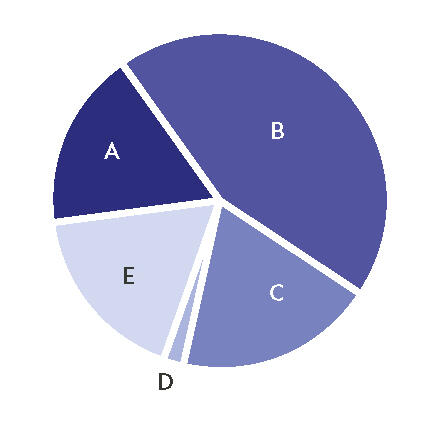
A. No Paid Staff Members - Entirely Volunteer Run, (17.3%, 9 Organisations).
B. 1 to 10. (44.2%, 23 Organisations).
C. 11 to 25. (19.2 %, 10 Organisations).
D. 51 to 100. (1.9%, 1 Organisation).
250 or more. (17.3, 9 Organisations).
Chart 2: Does your organisation have a volunteer organiser role?
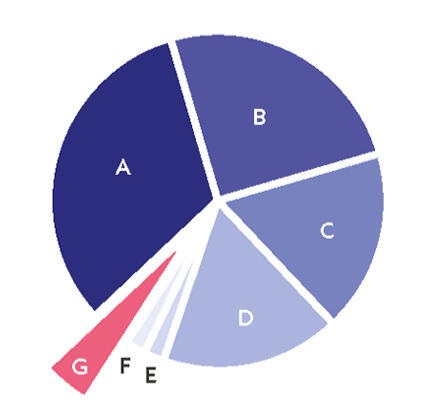
A. As part of a paid staff member’s duties (32.7%, 17 Organisations)
B. Shared by a few paid staff members (25%, 13 Organisations).
C. As a paid staff member’s entire role (17.3%, 9 Organisations).
D. A volunteer oversees other volunteers (17.3%, 9 Organisations)
E. Shared between paid employees and volunteers (1.9%, 1 Organisation).
F. Project based, so there aren’t always volunteers and their organisers (1.9%, 1 Organisation)
G. No (3.8%, 2 Organisations)
Chart 3: Do you collect equalities data about volunteers’ demographics and background (gender, age, etc)?
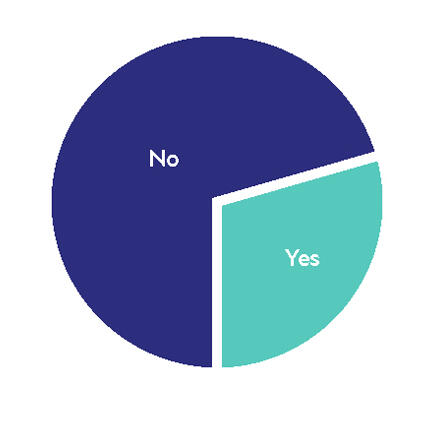
No (63.5%, 33 Organisations).
Yes (36.5%, 19 Organisations).
Chart 4: Would you be willing to share anonymised, summarised equalities information about your volunteers with Make Your Mark for the purposes of this survey?
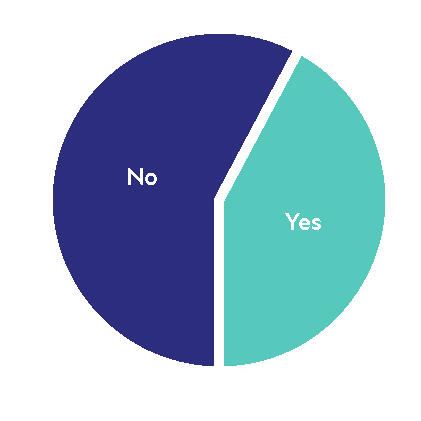
No (57.9%, 11 Organisations).
Yes (42.1%, 8 Organisations).
We chose to survey heritage sector volunteer organisers for two key reasons:
1. The heritage sector has a proven track record of working in partnership to achieve sectoral aims. The heritage sector published its first joint, national strategy Our Place in Time in 2014, which was refreshed with the publication of Our Past, Our Future in 2023. Make Your Mark was created as part of Our Place in Time, and with 87 members across Scotland is an initiative that demonstrates the capacity of the heritage sector to work together to implement change. We were able to tap into the history of collaboration and networking within the heritage sector and use Make Your Mark’s pre-existing networks to quickly gather data to produce a sector-wide picture of inclusive volunteering practices.
2. Existing research on demographics in the heritage sector indicates that the volunteer base is not very diverse across multiple dimensions, and predominantly consists of older, non-disabled, white people from less deprived areas. These are the same groups overrepresented in volunteering across Scotland’s wider voluntary sector (Scottish Government, 2021).This means that fostering inclusive volunteering practices in the heritage sector can have a large immediate impact, as well as provide a road map and case studies for other sectors to make a change.
Whilst the heritage sector provides an insightful picture of current inclusive volunteering practice, the survey data has limits. Recent research into the heritage sector highlights the current turbulence and uncertainty facing the sector, specifically how recent and current events like the COVID-19 pandemic and cost of living crisis are threatening the existence and sustainability of many heritage organisations across Scotland.The heritage sector relies on older volunteers, many of whom were and are shielding due to COVID-19 or are leaving roles due to health issues. According to the most recent UK Heritage Pulse Report on volunteering (2023), only 14.1% of respondents said volunteer recruitment had gone well, and only 8% of respondents said that attracting volunteers from a broad range of ages and backgrounds had gone well.According to the UK Heritage Pulse report on price increases and impact published in September 2022, only 47% of organisations felt confident or very confident they could accurately predict the financial outlook for their organisation over the next 12 months. While the cost of supplies and overheads was recorded as increasing for 91% of respondents, 55% of organisations had not implemented or planned any measures in response.This means that the survey data collected in February and March 2023 provides a snapshot in time, and is likely to change with the continued uncertainty and upheaval caused by the pandemic and inflation.
Diversifying Volunteering: Existing Approaches to Recruitment
The most popular method of recruitment was ‘word of mouth’ (92.3%). This could begin to explain why many heritage organisations have reported issues with recruiting a diverse range of volunteers (Carr, 2023). Oftentimes word of mouth promotion results in recruitment of people of similar backgrounds and experiences to the existing volunteer base.Organisations’ websites (76.9%) and social media (75%) were the next most popular recruitment methods. The high level of digital volunteer recruitment could be linked to organisations’ desires to recruit younger people, as people aged 19 – 29 are the most active age group on social media. However, a heavy reliance on digital media could exclude people who cannot afford computers or phones, have no time to go online due to work or other commitments, lack technological ability or experience barriers in using screen technology. Posters (32.7%), Make Your Mark portal (30.8%) and local volunteer centre or third sector interface (42.3%) all ranked as middling strategies.Partnering with local charities to engage with a more diverse range of volunteers was used as a recruitment method by 25% of respondents. Research and practice in inclusive engagement has shown that building relationships with groups representing marginalised people is the most effective way to diversify volunteer programmes. These groups are trusted messengers within communities and can provide feedback on how to make opportunities, sites, policies and practices more accessible (Volunteer Scotland, 2022).12 (92.3%) of the 13 respondents who indicated that they used this recruitment method were Make Your Mark members, representing about one third (31.2%) of campaign members who answered the survey. Only 1 respondent who indicated that they used this recruitment method was not a Make Your Mark member, representing 7.1% of non-campaign members who answered the survey. This is an early indication that the Make Your Mark campaign is successful supporting the development of more inclusive volunteering practices amongst members.
Qualitative Responses on Making Volunteering Inclusive
The survey contained options to write in free-text format to respond to set questions.
"How do you foster an inclusive environment for volunteers at your organisation?"
We offered some prompts for this question and many respondents referred to these, without necessarily unpacking what a ‘taster session’, ‘open days’, ‘try-out days’ or ‘multi-lingual provisioning’ might mean in their particular settings.Responses tended to gesture towards inclusive feelings that were not necessarily linked to clear policies or practices, e.g.: ‘We offer a friendly and open environment’. Only a slight majority of respondents (55.8%) stated that they had an organisation-wide equality, diversity and inclusion policies or guidelines.Many noted the interpersonal and relational aspects of creating a good atmosphere e.g.: ‘Nothing formal, just day-to-day interaction to create a welcoming environment’. This was linked with organisational methods of recruitment via personal relations and proximity:
‘volunteers are recruited through personal contact’
‘we rely on informal interaction’
Other responses noted ‘flexible’ methods, or ‘open’ opportunities, centring volunteers’ ‘choice’:
‘Volunteers may opt for their choice of role’
‘Role within X is flexible according to volunteers' needs and wishes’
It may be that having ‘no minimum expectations’ could create disadvantage and uncertainty rather than flexibility, as people new to volunteering generally or with a sector or organisation specifically may not have a sense of expectations, time commitments and benefits of volunteering, thereby dissuading them from getting involved.Similarly, there may be a missed opportunity to capitalise on volunteers’ full and pre-existing skill-set by emphasising ‘no experience is necessary’: across all ages and experiences, volunteers often want to consolidate their skill set and may look to be matched with organisations able to support this desire. For older volunteers in retirement this might be about recognising previous and ongoing skills in previous workplace contexts; for younger people this might be about building skills for future educational and/or employment opportunities. There are certain groups, particularly refugees and people seeking asylum, whose skills may not be fully recognised by their country of arrival. The emphasis on ‘no experience’ may not fully invite in or capitalise upon the valuable experiences of such groups.There was an assertion of organisational members and/or potential volunteers being free to choose or opt-in, e.g.: ‘All members are offered the opportunity to volunteer. Some do, some don’t. If interested we invite them along to spend some time with the people/section they are interested in’. However, recruiting from the existing membership base may not be effective in attracting new audiences and ensuring diverse recruitment. An insistence that ‘everyone is welcome’ may explain why there is a nervousness and/or reluctance around gathering and sharing EDI data that may indicate a lack of representation; this welcoming gesture may gloss over the hard work to be done in practising rather than expressing inclusion.Some respondents mentioned fostering inclusivity through adapting resources, opportunities and training. These adaptations were primarily related through the provision of materials, such as offering versions online and in print, and in languages other than English. Training was linked to often rather undefined skills workshops, inductions and training sessions, although some links were made between a skilling-up and a potential return to paid employment, e.g.: ‘ … supporting the community back into work roles if they wish …’). Several organisations mentioned additional support needs in terms of volunteers’ learning and language capacities:
‘We offer large print, dyslexic friendly fonts, are fully accessible and tasks can be tailored to suit individual needs’
‘We have a relaxed recruitment process. We supply information visually, verbally and written to enable wider access when engaging with materials. We can provide large print formats if needed’
More formal skills/qualifications were mentioned, e.g.: Duke of Edinburgh awards, school placements, buddy schemes, although the survey indicated that recruitment through educational providers was not prioritised, with only 1.9% of respondents listing it as a recruitment method.Several organisations were honest and upfront about the need to do more to make their organisation more inclusive:
‘We could do more here’
‘To be honest we are only now realising that we may not currently be inclusive, and are embarking on ways to volunteer that are inclusive’
‘Our initial volunteer interview process is very informal but your question has made me think we should be doing more!’
Such good intentions were also evident in statements such as:
‘We would adapt as necessary’
‘Nothing at the moment but we would like to consider options’
One respondent also indicated that the survey itself provided ‘food for thought!’. These seemingly indicate good intent, but may be less proactive and more reactive, as responsive to needs (e.g., specific volunteers’ requirements) or necessity (legislation/guidance). Several noted the limitations to developing inclusive policy and practice, including a lack of funding and/or staff, e.g. ‘We have no-one dedicated to volunteering full or part time’.Other organisations seemed versed in good policy and practice and could relate examples, using legalistic language to speak of ‘reasonable adjustments’ 3 and working with organisations and volunteers to ‘teach us how to be more inclusive and reach different audiences’:
‘Offering info on our website about some of the ways we are trying to reduce barriers to volunteering. Making inclusivity core to our work, not just to volunteering (eg. our collections reflect diverse people's lives and experiences; our programme includes diverse speakers, and creatives). Offering flexible volunteer roles which are tailored to volunteers' interests, availability, what they feel comfortable doing, what they want to learn. Offering different ways to apply. Accessible building, large print, wheelchair access, laptop set up for vols with visual impairment, etc. Clarity about our commitment to make volunteering accessible from the get go: on our website, when we meet vols for the first time, in the application form. Always asking what we can do to make it easier for them to be involved’.
Others spoke of in-person adaptation (‘Ask people if they need any adjustments and accommodate this where possible, tailoring volunteer experience to individual needs’), financial reimbursement (‘re-imbursement for costs incurred during volunteering’) and a range of non-financial benefits were also expressed such as ‘tea/lunch’ and ‘coffee morning’ provision.
Footnote
3. Reasonable adjustments are changes that organisations must make if being disabled puts someone at a disadvantage compared with others who are not disabled. A workplace adjustment is a change to a work process, practice, procedure or environment that enables an employee to perform their job. A workplace adjustment goes beyond the legal requirement of 'reasonable adjustment' – what an employer must do under Equality Legislation, and instead focuses on the aspiration of the employer we want to be – looking at what can be done rather than just what must be done. See gov.uk’s documents on Workplace Adjustments and the Onboarding Process, and Reasonable Adjustments for Disabled Workers for more examples.
"Why do you think people want to volunteer with your organisation?"
When asked about why people volunteered, emotional attributes (‘love’, ‘belief’, ‘passion’), personal and social connections (‘combating loneliness’, ‘fun’), responsibilities and duties (‘to give something back’) and leisure/hobbies (‘keeping busy’) were consistently emphasised. There was a degree of self-praise for their own ‘welcoming organisations’, whereby volunteers become organisational advocates, e.g.: ‘They want to meet new people and tell the story of the project’.There was some linkage to skill sets and developing a CV which arguably positioned volunteers as unskilled, building their CV and acquiring experiences, rather than primarily sharing these. There was a binary between older and younger volunteers with younger volunteers positioned as CV-builders, while older people (‘retirees’) were simply ‘looking to be involved in something’:
‘We have a higher amount of older volunteers past retirement age that either used to work with the machinery that we store and display and so they like to continue to use their skills to help the museum maintain them or have interest in museums and would like to be involved in some capacity now that they are out of work. The younger volunteers we have are either of school leaving/university age and looking for experience in this field or are refugees settled in the area.’
"What barriers could prevent or dissuade people from volunteering with your organisation?"
Respondents identified a range of barriers which might act to prevent or dissuade people from volunteering, including a sense of limited finances and time.Significantly, the onus was often put back on the individual volunteers to come forward to participate, even as structural inequalities were identified. This was evident in statements around volunteers ‘choosing’ their role and organisations being ‘open’ to everyone, which was contrasted with an acknowledgement of a sense of limitation, for example around volunteers’ temporal and economic resources and sites’ inaccessibility. Having ‘confidence’, ‘knowledge’ and ‘technological’ or ‘communicative skills’ represented another way of framing access as something volunteers themselves could challenge by effectively ‘skilling-up’.Barriers were also identified and located within existing voluntary organisations, which included the physical premises of buildings, often seen as just matter-of-fact or insurmountable:
‘Poor heating in an old building’
‘We have a huge barrier with the age of the museum that we cannot do anything about’
‘We are located on a cobbled street which is difficult to navigate’
‘listed building’
‘access only by car’
Interestingly both old and new sites related these physical factors, framed as factual and potentially leading to an unchanging and narrow view of ‘the problem’, seen as one of ‘objective’, ‘unchanging’ infrastructures (buildings, stairs, streets, cars) rather than as a necessary responsiveness to equality legislation and protected characteristics.Respondents also identified barriers in the felt cultures of groups. Everyday cultures, expectations and assumptions of organisations may be felt as, for example, white and/or middle-class and may mean that marginalised ethnic groups and/or those from working-class backgrounds feel less welcome. Some organisations are known and even celebrated as large, well-funded, prestigious and elite, and with fee-paying membership bases. These realities may not best signal organisational commitment to EDI.Notably, there was reported staff resistance to expanding and diversifying volunteering, including through reimagining and varying roles, with suspicion that increasing volunteering numbers could be used to reduce paid staff, e.g. ‘Currently working on increasing the variety of roles. Still some staff resistance’. Such sensitivities may at least partly explain general reluctance to share equalities data, which itself acts as a barrier to understanding and transforming the sector.
Focus Groups on Inclusion and Volunteering
To gain an understanding of barriers and enablers to volunteering from marginalised people, the project partnered with several volunteering organisations working with specific marginalised groups including African and Caribbean people, Muslim women, and disabled people. We also conducted a focus group with students, with LGBTQ+ representation.Questions focused on participants’ experiences and perceptions of volunteering in Scotland, as well as barriers to volunteering and how these could be removed.Focus groups varied between 5-12 members and ranged in age from ‘18-29’ to ‘70 and over’, describing themselves as ‘African, African Scottish or African British’, ‘African: any other African ethnic group’, ‘Caribbean, Caribbean Scottish or Caribbean British’, ‘Caribbean or Black: any other Caribbean or Black ethnic group’, ‘Asian, Asian Scottish or Asian British’, ‘Pakistani, Pakistani Scottish or Pakistani British’; ‘White: Scottish’, ‘White: Other British’, ‘White: Irish’. Participants described themselves Buddhist, Christian, Muslim and not religious. Participants identified as cis gender, trans gender and non-binary. As indicated by partial postcode data, participants also lived in areas of varying advantage and disadvantage, according to the Scottish Index of Multiple Deprivation.Whilst focus group participants represented a range of ages, ethnic groups, genders, religious backgrounds, abilities, sexualities and socioeconomic backgrounds, participants were all based in the Central Belt of Scotland.Participating in the focus groups could itself be seen as mirroring some of the broad concerns around inclusive volunteering in terms of who enters and gets involved in community spaces, and who and what is recognised, supported and remunerated.To enable a diverse range of people to participate, focus group participants were offered a gift token and lunch as recognition of time and energy invested in this process.As facilitators we asked participants how we could facilitate their participation in the group and support those with experiences of financial hardship, gendered care, experiences of discrimination, socio-legal precarity, and cultural and linguistic diversity.The following is a summary of the focus groups:
Focus Group A
Large Scotland-based community-led grassroots organisation centred on disability rights, advocacy, policy, and awareness.
This focus group foregrounded the joys, pleasures, frustrations, and barriers associated with volunteering. In this focus group, skills development was a secondary factor in participating in volunteering. Purpose, social value and social connections were a much bigger imperative.
Highlights included:
A powerful sense of being valued, feeling belonging and having purpose.
Creating opportunities for other disabled people.
Improving an understanding of how to work with disabled people (from staff, to volunteers and user communities).
New social networks and opportunities.
Challenges included:
Basic awareness of disability and access within volunteering organisations.
Becoming the resident ‘expert’ on all disability.
Finding good, flexible opportunities to accommodate conditions (e.g. chronic illness).
Feeling like a ‘problem’ for asking for adjustments.
Significant barriers included:
Lack of resources (e.g. screen readers) within organisations.
Lack of organisational awareness or understanding of disabilities.
Lack of information about what reasonable adjustments can be accommodated within organisations.
Lack of dedicated resources to support access (e.g., additional travel expenses).
Focus Group B
Muslim women-led grassroots organisation informed by an intersectional approach to women’s inclusion in Scotland.
This focus group centred education, compassion and equalities in their discussion. There was a discussion of how equalities work had positively influenced Scottish institutions over the decades, especially in relation to race. However, a number of culturally-specific issues could be improved.
Highlights included:
Taking a compassion and empathy-centred approach to societal contribution.
Learning from others, others learning from you.
Creating cultures of openness by meeting new people from different walks of life.
Aligning culturally-important values around community service with broader volunteering opportunities.
Challenges included:
Basic financial support (especially around childcare and transport).
Cultural sensitivities (especially around confidentiality of personal circumstances).
Lack of skills development.
Lack of support for wellbeing.
Significant barriers included:
Family or community judgement.
Lack of recognition or value.
Being overworked, especially in emotionally intensive investment.
Support for understanding disability in minority religious and cultural volunteer-led organisations.
Focus Group C
Black-led organisation fostering community and cultural programming for African and Caribbean heritage people in Scotland.
This focus group foregrounded very basic barriers to inclusion, especially for refugees and people seeing asylum in Scotland. The conversation ranged across a variety of topics but social integration, skills development and employment were recurring concerns.
Highlights included:
A positive way to meet people from different cultures and connect.
A mechanism for reducing isolation and loneliness.
A route to developing skills that can directly aid employment.
A method for developing new social networks, especially for newer migrants, people seeking asylum and refugees.
Challenges included:
Accessing ‘good’ volunteering opportunities that can help to build diverse skills.
Knowing how to access opportunities and how different voluntary sectors advertise.
Decreasing opportunities for ‘lived experience’ volunteering in the NHS.
Openness and transparency about how ‘good’ volunteering opportunities with support (e.g., for travel expenses) are allocated.
Significant barriers included:
A lack of response to volunteering applications and enquiries.
Hesitation and confusion around volunteering and employment rights for people seeking asylum (amongst volunteer organisations).
Accessing information about opportunities.
Availability of opportunities beyond retail.
Support with childcare costs and transport.
Focus Group D
Students from diverse cohorts at a major Scottish university.
This focus group surfaced broader questions about the nature of volunteering, especially what ‘counts’ as volunteering (mutual aid, grassroots activism, etc).
Highlights included:
Volunteering having the potential for positive social change.
Volunteering helping with skills development.
Opportunities for learning and meeting new people.
Opportunities to contribute to collectives with a common purpose.
Challenges included:
Available time to volunteer, especially through the cost of living crisis.
Finding opportunities in organisations which share values about diversity and inclusion.
Perception that volunteering is there to escalate the careers of middle-class young people.
Confidence in the ‘value’ of the opportunity, especially when other forms of unpaid work are available.
Significant barriers included:
Financial.
Cultural: a gap between attitudes to social justice amongst particular groups and the organisational demographics.
Agency: a lack of opportunities where your voice or contribution can help to enact change or make a difference.
Focus Group Data Analysis
The four focus groups contained much rich insight, discussion and debate and it was clear that people have much knowledge, passion and experience in and for the subject area. Alongside both new and sustained commitment to volunteering – as a lived experience and as a sense of future possibilities – focus groups highlighted several challenges around inclusive volunteering. There were different opinions about the worth and cost of volunteering, both socially and individually, with the call for a diversity of approaches and opportunities, including for recruiting within and through minoritised communities by using diverse channels to advertise opportunities (e.g. local LGBTQ+ cafés, Afro Caribbean cafés, WhatsApp groups, Facebook membership pages, etc.).Three focus groups mentioned ‘box ticking’ as a tokenistic measure involving organisations gesturing towards equality and diversity but without creating full and sustainable change ("Was it just a tick-box exercise? Like, I’m determined that they will be accessible, whether they want to be or not", Group A). While many had a sense of agency and commitment to making change and for ‘people like us’, there is a need to think beyond asking people to find their own solution to the ‘problem’. Making minoritised groups always and fully welcomed, equipped and supported in the sector should be a norm.Notably, racialised inequality and discrimination was often not explicitly named as racism but rather often implied and gestured towards amongst focus group members, revealing the difficulty and potential unease in naming inequalities. That said, one group did mention ‘subtle racism’ ("I think there’s subtle barriers but I think there’s subtle racism. When young people go for jobs they get the degrees and it’s very difficult. Sometimes you have to go down south to get the experience and then come back up", Group B). Here, the ‘confidence’ in naming inequalities, particularly racism, was seen to implicate both individuals and organisations - confidence for minoritised people to speak and a confidence in volunteering organisations about how to make those voices more meaningfully heard. Interestingly, ‘whiteness’ as a structuring force beyond individualised racialised bodies was named by the student focus group whose members were all white:
"It can also be about sort of spaces appearing sort of like white spaces, you know? And if something sort of appears as sort of like white space, because actually there’s a lot of white power there and, you know, there’s predominantly white people who are kind of, sort of historically involved in a particular field, then there can be a different sense of comfort in deciding that you’re going to volunteer in that space, you know, depending on, you know, whether you have white skin or black skin or a person of colour."
(Group D)
Respondents spoke variously about group precarity (e.g. as students, Muslim women, Afro Caribbean women and men, refugees, people seeking asylum, disabled people, members of the LGBTQ+ community) where social and legal futures were not always felt as secure, safe or even known). Many of the issues that participants and organisations grappled with speak to broader societal inequalities and vulnerabilities, including having a safe and accessible usable space for members, providing childcare and making an inclusive space even with the challenges of resources, infrastructure and investment.
"Yeah, childcare could be an issue, as well, you know, for a family. You know? Where to keep the child, or who is going to volunteer? That could be a big problem. So childcare is a massive thing."
(Group C)
While barriers against participating are outlined in the above example, conversely, there can be a compulsion to volunteer given the lack of and/or inability to work.
"I feel like another group that volunteers would be the asylum seekers, definitely, because they are not allowed to work. So it’s their only other option to, like, keep busy, and at least have that in your case, as well. Because, at the end of the day, you are going to be asked how you’ve been integrating with the surroundings, so since you can’t work, you can’t do any other thing, you only have one option, to volunteer."
(Group C)
Participants have been living through various periods of crisis including the contemporary cost of living crisis and the COVID-19 pandemic. It is important to remember that these are local, national and international crises and implicate participants in wide networks, including as migrants, first generation citizens and people seeking asylum, and as members of families and communities.
"As well as we want to communicate it [information] in English, we also want to make sure that we communicate it in the languages that people best understand, just so that they get the information properly. And that’s what we did successfully in COVID, you know, and we want to continue to be doing that."
(Group C)
Speaker 1: …Because providing time and energy for free during a cost of living crisis doesn’t feel like a benefit. Does that make sense?Speaker 2: I mean we were talking earlier about government cuts kind of creating like more of a need for volunteering, so kind of from that point of view, so the economic, like well we’re trying to fill the gaps that the government should be filling by getting like random people to step up and, you know, take on those responsibilities, even though they probably already have plenty of responsibilities of their own. And like from that point of view, like from a capitalist point of view, like no one actually cares about people. So it’s got to be more of an economic thing. Sorry that’s quite cynical, but it’s true.
Imagining populations as having needs in and beyond ‘crisis’ contexts may help more fully situate volunteers as equipped with a range of skills, preferences, choices and as having needs and critical concerns. In this we see a challenge to wholly positive, naïve or traditional ideas of volunteering, which may reinforce gender inequality:
"So like the Scottish Government kind of definition of volunteering, like is a housewife a volunteer? Like I feel like she ticks the same boxes, you know?"
(Group D)
Common concerns were around the transactional nature of volunteering and how to best think about the exchange of skills, expenses, friendship and, importantly, the forms of recognition involved:
"People’s reasons for volunteering … I mean, the fact that there is no compensation means that value should be the compensation. There’s also picking up skills, but again, that’s a secondary thing."
(Group A)
"I think in our culture it’s more – it’s a sense of perhaps obligation."
(Group B)
There were ideas of how the potential for invisibility or inequality (‘obligation’), and even exploitation (‘working for free’) could be offset by a commitment to equality, diversity and inclusion values and practices. Diversity could be imagined through having a varied offering of roles rather than to be filled or signalled by ‘diverse people’. Reciprocity was also valued in that if organisations use volunteers, this use should be rewarded and celebrated, where volunteers become ‘part of it’, reflected in the commonly related experience that lived experience was often shared between service providers and service users:
Speaker 1: You’ve been welcomed that’s a big thing, you know, you don’t feel you’re a volunteer, you feel you’re a part of it.Speaker 2: Also it’s accepting the diversity, acknowledging it and bringing to context, you know, not making someone feel outsider.(Group B)
"I was a good way of attracting other disabled people to volunteer, and be all inclusive, and all that. Which I didn’t see as being a bad thing, but I thought, ‘There’s a lot that can be learned on both sides here, including the people recruiting the volunteers.’ So when I was in, I took charge of a few things."
(Group A)
"But also I think you can’t really bring it home to yourself, you know, what you’re experiencing. Volunteering if it’s like you’re dealing with depression or anxiety or something, you know, you can’t bring it home, you have to just leave it there. There’s only so much you can do really. The other thing I feel in volunteering you can do for an organisation, you know, something you’ve experienced yourself so you can relate better. For instance like bereavement I feel if I’ve experienced that so I can help somebody in that. It helps yourself as well by helping somebody else going through that."
(Group B)
All focus groups mentioned the need to think of volunteering as involving a wider set of opportunities: some respondents lived with the reality of often feeling undermined and under-appreciated, where assumptions were made about incapacity particularly in terms of race, gender, disability and social class:
"What I’ve found sometimes is, like, charities that are for disabled people sometimes seem quite taken aback that disabled people want to volunteer for more active physical roles."
(Group A)
"Sometimes you apply for where you want to volunteer, and then they never call you back… they were asking me to go and bring proof of address, bring this, bring … I sent everything to them, they didn’t call me. But the other person, she was not asked anything. They just asked her to come, and they interviewed, and she was given the place, and she is still there until now … Yeah. I have known a lot of people, because of their status they have been unable to volunteer. Because, like, when they settle, they really are interested in, like, the NHS, for example, or schools, education, they will ask them for a reference, and it can be very, very difficult to get one. It is not really open to everybody."
(Group C)
There are questions of resources and training within these mis-recognitions ("recognising that the barrier isn’t your impairment; it’s the lack of support" Group A) and focus group A in particular talked about making ‘reasonable adjustments’, while all groups were attentive to volunteering opportunities being aligned to personal needs and desired benefits:
“But how would reasonable adjustments, like, be defined? And I guess, in terms of volunteering, yeah, that could be a barrier,
just depending on what an organisation is willing to do, or to spend, to make volunteering accessible.”(Group A)
“Maybe creating opportunities to say, ‘If there is ever going to be a gap in your volunteering, that’s okay, let us know, and we can make an arrangement,’ rather than losing a volunteer altogether … I volunteered in the past, with a couple of different youth organisations, but I found, because my health conditions are
unpredictable, and a lot of those things are scheduled, I had to stop volunteering, because I wasn’t reliable.”(Group A)
All focus groups mentioned the need to think of volunteering as involving a wider set of opportunities: some respondents lived with the reality of often feeling undermined and under-appreciated, where assumptions were made about incapacity particularly in terms of race, gender, disability and social class:
“What I’ve found sometimes is, like, charities that are for disabled people sometimes seem quite taken aback that disabled people want to volunteer for more active physical roles.”(Group A)
“Sometimes you apply for where you want to volunteer, and then they never call you back… they were asking me to go and bring proof of address, bring this, bring … I sent everything to them, they didn’t call me. But the other person, she was not asked anything. They just asked her to come, and they interviewed, and she was given the place, and she is still there until now … Yeah. I have known a lot of people, because of their status they have been unable to volunteer. Because, like, when they settle, they really are interested in, like, the NHS, for example, or schools, education, they will ask them for a reference, and it can be very, very difficult to get one. It is not really open to everybody.”(Group C)
There are questions of resources and training within these mis-recognitions (“recognising that the barrier isn’t your impairment; it’s the lack of support” Group A) and focus group A in particular talked about making ‘reasonable adjustments’, while all groups were attentive to volunteering opportunities being aligned to personal needs and desired benefits:
“But how would reasonable adjustments, like, be defined? And I guess, in terms of volunteering, yeah, that could be a barrier, just depending on what an organisation is willing to do, or to spend, to make volunteering accessible.”(Group A)
“Maybe creating opportunities to say, ‘If there is ever going to be a gap in your volunteering, that’s okay, let us know, and we can make an arrangement,’ rather than losing a volunteer altogether … I volunteered in the past, with a couple of different youth organisations, but I found, because my health conditions are unpredictable, and a lot of those things are scheduled, I had to stop volunteering, because I wasn’t reliable.”(Group A)
A key area through which to signal a commitment to EDI was in engaged recruitment, involving marginalised communities from the outset, including in imagining volunteering opportunities, rather than as somewhere to ‘outreach’ to or recruit from. A more ‘of, with, for, by’ approach was preferred, with privilege at times overtly named:
“For me when I think of volunteers I think of my middle-class peers at university who had the time to do that because their parents paid for their rent, and I had to go and actually work to pay for my rent.”(Group D)
“And because pantries, for example, they offer more choice and more dignity than perhaps are perceived in food banks, you know? And then I kind of also thought about a thing that I volunteered for, although I wouldn’t call it volunteer, but I would think about getting involved in the community in a different way, you know? And it was the [anonymised] which was … with a demographic that was predominantly women and predominantly middle-class white women. Not exclusively, but predominantly, you know? So, you know, I think really you really need to think about the kind of organisation that it is, you know, and where it’s come from, you know, where the impetus has come from, in terms of volunteering and, you know?”(Group D)
Involvement, engagement and recruitment was seen as a way to start from and learn with minoritised groups, utilising different strategies and thinking through specific and specialist contributions that volunteers may offer:
“Advertise in, like, African communities. This is something I just learnt quite recently. Every African country has a WhatsApp group. Right? Every African country has a WhatsApp group, where everyone is there. So, like, for volunteering opportunities, let them advertise there. You know? Find the people that run these groups, or if there’s nobody in particular running them, just get someone who is in the group.”(Group C)
“Because they [teachers] thought she was autistic they didn’t introduce her to the Arabic language because we read the Quran as Muslims. So we [volunteers] start teaching kids maybe from earlier on so they learn Arabic alphabet, then they join letters and read the Quran. She’s not been introduced at all because they thought, oh no it will be too much for her.”(Group B)
While all participants expressed moments of hope and joy in and across the sector, particularly in terms of ‘making a difference’ to other people, including ‘small changes’, at times this was tempered with a sense of limitation in re-imagining bigger sector-wide and indeed societal changes:
"So I guess part of the idea, the point of kind of more inclusive volunteering would be to like bring in new perspectives and new voices, but at the same time like as a volunteer how much, you know, how much influence would you have if you were like volunteering in a museum? You could be like ‘oh hey that’s kind of, you know, why don’t you include something, a Black artist’, or, you know, whatever historians, ‘in this exhibit?’ But, you know, the head curator’s not necessarily going to listen to you."
(Group D)
Speaker 1: I think another thing that sometimes I’ve across, not here, believe me not here, but in other places I’ve volunteered, it’s felt so tokenistic and yeah we really want you here, we need you to be here, we need your experience and things like that but you really feel you’re only there to tick the box. Because they’ve got a criteria of people that they need and they maybe need – quite often the tokenistic old person or … you’re important because you represent the disabled community and so it’s, you know, that you’re just there to tick that box.Speaker 2: You’re there just for that – just for …Speaker 3: Just for the numbers sake.Speaker 4: It’s just to fill that quota isn’t it.(Group B)
The critique of filling a quota, or ticking a box, touches on superficial inclusion policies, as gestures which do not realise equality, diversity and inclusion as an ongoing and resourced effort. This is made all the more problematic when ‘doing good’ can also gloss over questions of reciprocity, remuneration and recognition, as well as broader social justice:
"It’s unpaid labour. Like that’s how I feel … And there’s a part of me that feels with volunteering as well that people to do it to like make themselves feel better about their own privilege, like so I think that you could call it social good. If you have to categorise in one of those things, whether it’s altruism or to get ahead, my cynicism makes me think that it’s, people say that it’s for the social benefit but it’s actually for to give themselves the skills that they know that they can access through that. "
(Group D)
"So like I used to volunteer a lot in my church with kind of like, kind of the kids work and things like that, and they’d always be like ‘come on everyone, we’re a big church, there’s like hundreds of people here. Can some other people volunteer instead of just the same person always like doing the coffee or the flowers?’ And it’s just, it does tend, yeah, so. And again I know that’s like a gendered thing as well, but it’s just like, it does tend to be the same people who volunteer for everything and then get burnt out."
(Group D)
Speaker 4: It’s like box ticking. So like Black Lives Matter and things like that and, you know, Defund the Police, Abolish the Police, Abolish Borders, things like that. Like is that volunteering in the same way, because it’s definitely about like correcting and like addressing a social ill? And like so people within that who volunteer for organisations that are addressing those issues, like is that not volunteering as well? Or is it activism? So like the Scottish government kind of definition of volunteering, like is a housewife a volunteer? Like I feel like she ticks the same boxes, you know.
(Group D)
We have deliberately included lengthy quotes in this section to amplify the responses of the focus group participants. Collectively, they raise issues related to the perception of volunteering, economic barriers to access, as well as offering a critique about the ‘value’ of volunteering. The benefit of inclusive volunteering isn’t simply to diversify who volunteers in organisations; it also includes expanding how we count and value the role of volunteering in inclusive social and economic prosperity in Scotland.
4. Recommendations
Drawing on existing literature, a new survey and specially-commissioned focus groups, this project found that there was a large variation in approaches to making volunteering more inclusive in Scotland, with initiatives often being driven by key individuals. While this is a natural consequence of the informality around much volunteering (and is an important benefit in terms of flexibility), it can unintentionally foster the very same inequalities that volunteer organisations work so hard to overcome in their social mission.By working with members of Make Your Mark, and a range of community-centred focus groups, we identified key recurring barriers, including:
1. Using inclusion-focused best practice in volunteering to drive change.
1a. There is a general under-confidence in policy, legislation, and practice (with some exceptions).
1b. There is variation in data collection to track the participation of volunteers with protected characteristics meaning organisations cannot not confidently identify and evidence issues related to inclusion.
1c. There is a lack of high-quality data to begin national or local equalities-focused benchmarking (e.g. around participation rates).
2. Ensuring broad and open approaches to engagement and participation.
2a. Economic barriers have worsened due to the cost of the living crisis and have disproportionately impacted marginalised communities.
2b. Many existing approaches to volunteer recruitment fail to reach a fuller range of Scotland’s diverse population (e.g. through the production of accessible materials or recruitment through a range of community channels).
2c. Perceptions about ‘who’ volunteering is for continue to shape the volunteering sector and entrench existing inequalities.
A lot of groundwork is required before there can be a national approach to benchmarking progress in equalities and inclusion in the volunteering sector in Scotland. There is a danger that partial data will skew the ‘real’ picture, and that only large, well-resourced, organisations with distinct volunteering demographics will be captured. Our recommendations are focused on developing knowledge, skills, and capacity in inclusive volunteering across Scotland, and across volunteering sectors.The key recommendations from this project include:
More active support for organisations undertaking inclusive volunteering initiatives (through an advocacy body such as Make Your Mark or Volunteer Scotland).
Creating a tiered national framework for inclusive volunteering that can help to structure the development of organisations and groups depending on their size and capacity.
Developing Communities of Practice for reflections on the process: what went well / suggestions of what to do differently.
Working in partnership with community, social, and third sector organisations led by under-represented groups and communities in order to model collaborative leadership in equalities.
Working with marginalised people to co-design flexible and varied volunteer roles that suit a range of volunteers’ needs.
Prioritising the hiring of volunteer engagement professionals, who, if-well resourced, can support a range of volunteers and ensure they have a good experience.
Access to additional financial resources to support volunteers facing the most severe economic barriers.
Developing inclusive volunteering case studies (from organisations who have delivered an inclusion action plan).
Raising awareness on the importance of collecting equalities data and offering tailored support to benchmark equalities data and set individual organisational action plans and targets.
Supplementary resources to support existing material on GDPR and safe data storage in relation to personal information and data collected for equalities.
Establishing trusted repositories of sectoral and national equalities data around volunteering.
Bibliography
Carr, F. (2023). Spotlight on: Volunteering. UK Heritage Pulse.Clement, L., & Lafferty, S. (2015). Youth Volunteering in East Dunbartonshire: The Lived Experience. Kirkintilloch: East Dunbartonshire Voluntary Action.Ellis, A. (2004). Generation V: Young People Speak Out On Volunteering. London: Institute for Volunteering Research.Gaskin, K. (2004). Young People, Volunteering and Civic Service: A Review of Literature. London: Institute for Volunteering Research.Hardill, I., & Baines, S. (2011). Enterprising Care? Unpaid Voluntary Action in the 21st Century. Bristol: Policy Press.Hardill, I., Baines, S., & Perri 6. (2007). Volunteering for All? Explaining Patterns of Volunteering and Identifying Strategies to Promote It. Policy & Politics, 35(3), 395-412.Harflett, N. (2015). "Bringing Them With Personal Interests": The Role of Cultural Capital in Explaining Who Volunteers. Voluntary Sector Review, 6(1), 3-19.Kanemura, R., Chan, O., & Farrow, A. (2022). Time Well Spent: Impact of COVID-19 on the Volunteer Experience. London: The National Council for Voluntary Organisations.Linning, M., & Jackson, G. (2017). Young People in Scotland Survey 2016. Stirling: Volunteer Scotland.Lukka, P., & Ellis, A. (2001). An Exclusive Construct: Exploring Different Cultural Concepts of Volunteering. Voluntary Action, 3(3), 87-109.Lum, T., & Lightfoot, E. (2005). The Effects of Volunteering on the Physical and Mental Health of Older People. Research on Aging, 27(1), 31-55.MacDonald, R. (1996). Labours of Love: Voluntary Work in a Depressed Local Economy. Journal of Social Policy, 25(1), 19-38.Maltman, D., Jackson, G. & Linning, M. (2020). Young People in Scotland Survey 2019. Stirling: Volunteer Scotland.**Maltman, D., Jackson, G., Stevenson, A. & Linning, M. (2019). **Volunteering in Scotland: Findings from the Scottish Household Survey 2007-2017 Full Report. Stirling: Volunteer Scotland.Phillips, R. (2010). Initiatives to Support Disadvantaged Young People: Enhancing Social Capital and Acknowledging Personal Capital. Journal of Youth Studies, 13(4), 489-504.The National Council for Voluntary Organisations (2021). Equity, Diversity and Inclusion in Volunteering. London: The National Council for Voluntary Organisations.The Scottish Government (2014). Our Place in Time: The Historic Environment Strategy for Scotland. Edinburgh: The Scottish Government.The Scottish Government (2018). Volunteering in the Year of Young People. Edinburgh: The Scottish Government.The Scottish Government (2019). Volunteering for All: Our National Framework. Edinburgh: The Scottish Government.The Scottish Government (2022). Workplace Adjustment: Onboarding Process - Equality Impact Statement. Edinburgh: The Scottish Government.UK Heritage Pulse (2022). UK Heritage Pulse: Survey 2 - Survey Results and Analysis. UK Heritage Pulse.Volunteer Scotland (2022a). Young People in Scotland Survey. Stirling: Volunteer Scotland.Volunteer Scotland (2022b). Volunteer Practice Guidance Note Top Tips Inclusion in Volunteering - The Common Areas. Stirling: Volunteer Scotland.
Further Reading
Anderson, P., & Green, P. (2012). Beyond CV Building: The Communal Benefits of Student Volunteering. Voluntary Sector Review, 3(2), 247-256.Bennett, M., & Parameshwaran, M. (2013). What Factors Predict Volunteering Among Youths in the UK? Third Sector Research Centre, Working Paper 102.Binder, M., & Freytag, A. (2013). Volunteering, Subjective Well-Being and Public Policy. Journal of Economic Psychology, 34, 97-119.Bradford, S., Hills, L., & Johnston, C. (2016). Unintended Volunteers: The Volunteering Pathways of Working Class Young People in Community Sport. International Journal of Sports Policy and Politics, 8(2), 231-244.Brewis, G., Russell, J., & Holdsworth, C. (2010). Bursting the Bubble: Students, Volunteering and the Community. London: Institute for Volunteering Research.Brooks, R. (2007). Young People’s Extra-Curricular Activities: Critical Social Engagement - Or “Something for the CV”? Journal of Social Policy, 36(3), 417-434.Clary, E., Snyder, M., & Stukas, A. (1996). Volunteers’ Motivations: Findings From a National Survey. Nonprofit and Voluntary Sector Quarterly, 25(4), 485-505.
Appendix A:
Focus Group Questionaire
1. Do you think there is a typical volunteer? If so, who are they?
2. Do you think people volunteer:
2a. Because they’d like to make a social contribution?
2b. Because they’d like to improve their CV/employment opportunities?
2c. Both – but which is the bigger motivator?
3. In your view, what are the benefits of volunteering? What are the drawbacks? (Too time consuming? Too expensive? Need to work?)
4. Do you think volunteering is an important contribution to society? Why? Are some kinds of volunteering (for example, in a school or hospital) more important than other kinds (for example, in a museum or community centre)?
5. What do you think EDI challenges are in volunteering? Is volunteering accessible to all?
6. Is whether or not you’re paid the only difference between working and volunteering?
7. For those of you who volunteer, where do you volunteer?
8. For those of you who don’t, is it something you’d consider doing? What kind of volunteering would you like to do and why?
9. The definition of volunteering used by the Scottish Government includes :“the giving of time and energy through a third party, which can bring measurable benefits to the volunteer, individual beneficiaries, groups and organisations, communities, environment and society at large. It is a choice undertaken of one’s own free will, and is not motivated primarily for financial gain or for a wage or salary.”
9a. Do you think mutual aids (a voluntary group or community which shares and swaps skills and resources) are a form of volunteering? Or are they something else?
9b. Do you think grassroots DIY cultures (for example a feminist collective) count as volunteering? Or are they something else?
10. Do you think belonging to marginalised communities (for example, LGBTQ+ communities, BAME communities) makes you more or less likely to volunteer? Why?
11. Do you think being from a working class background makes you more or less likely to volunteer? Why?
(loop back and cross reference to the answer to Q1, people may contradict themselves, useful to explore why if this happens).
12. With the cost of living crisis, do you think the primary societal benefit of volunteering today is social (helping people) or economic (providing time and energy for free)?
13. If you could set up a volunteering organisation tomorrow, what would it be for/about?
Appendix B:
Focus Group Demographics
1. What is your postcode?
2. What is your age range?
Under 18
18 to 29
30 to 39
40 to 49
50 to 59
60 to 69
70 and over
Prefer not to say
3. What is your gender?
Agender
Genderqueer or genderfluid
Man
Non-binary
Questioning or unsure
Woman
Prefer not to say
Other (write in):
4. Do you identify as transgender?
Yes
No
Prefer not to say
5. What is your sexuality?
Aromantic
Asexual
Bisexual
Gay
Lesbian
Pansexual
Queer
Questioning or unsure
Straight (heterosexual)
Prefer not to say
Other (write in):
6. What is your religion?
Church of Scotland
Roman Catholic
Other Christian
Muslim
Buddhist
Sikh
Jewish
Hindu
Pagan
None
Prefer not to say
Other (write in):
7. What is your ethnicity?
African, African Scottish or African British
African: any other African ethnic group
Arab, Arab Scottish or Arab British
Asian, Asian Scottish or Asian British
Pakistani, Pakistani Scottish or Pakistani British
Indian, Indian Scottish or Indian British
Bangladeshi, Bangladeshi Scottish or Bangladeshi British
Chinese, Chinese Scottish or Chinese British
Asian: any other Asian ethnic group
Black, Black Scottish or Black British
Caribbean, Caribbean Scottish or Caribbean British
Caribbean or Black: any other Caribbean or Black ethnic groups
White: Scottish
White: Other British
White: Irish
White: Gypsy / Traveller
White: Roma
White: Polish
White: any other White ethnic group
Mixed or multiple ethnic groups
Other (write in):
8a. Do you have a physical or mental health condition lasting or expected to last 12 months or longer?
Yes
No
Prefer not to say
8b. (If answered "Yes" to 8); Does this illness or condition affect you in any of the following areas?
COVID / long COVID
Dexterity (for example lifting or carrying objects, using a keyboard)
Energy levels (fatigue)
Hearing (for example deafness or partial hearing)
Learning or understanding or concentrating
Memory
Mental clarity (brain fog)
Mental health
Mobility (for example walking short distances or climbing stairs)
Physical pain
Stamina or breathing fatigue
Socially or behaviourally (for example associated with autism, attention deficit disorder or Asperger’s syndrome)
Vision (for example blindness or partial sight, cataracts)
Prefer not to say
Other (write in):
End of Form.
